翻译 糖尿病
sick person翻译
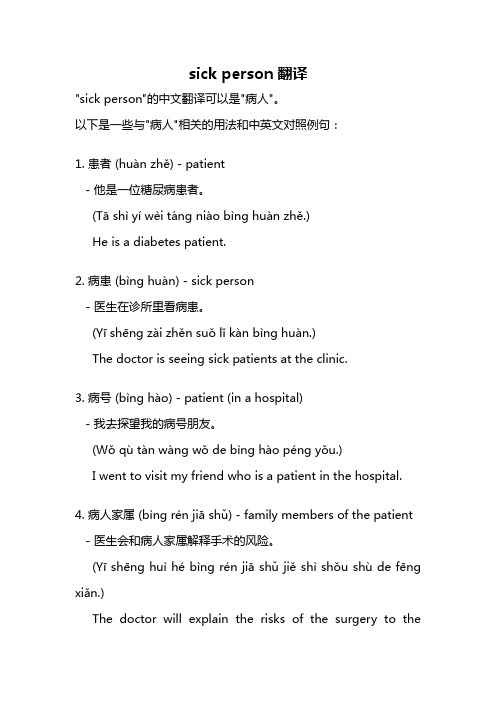
sick person翻译"sick person"的中文翻译可以是"病人"。
以下是一些与"病人"相关的用法和中英文对照例句:1. 患者(huàn zhě) - patient- 他是一位糖尿病患者。
(Tā shì yí wèi táng niào bìng huàn zhě.)He is a diabetes patient.2. 病患(bìng huàn) - sick person- 医生在诊所里看病患。
(Yī shēng zài zhěn suǒ lǐ kàn bìng huàn.)The doctor is seeing sick patients at the clinic.3. 病号(bìng hào) - patient (in a hospital)- 我去探望我的病号朋友。
(Wǒ qù tàn wàng wǒ de bìng hào péng yǒu.)I went to visit my friend who is a patient in the hospital.4. 病人家属(bìng rén jiā shǔ) - family members of the patient - 医生会和病人家属解释手术的风险。
(Yī shēng huì hé bìng rén jiā shǔ jiě shì shǒu shù de fēng xiǎn.)The doctor will explain the risks of the surgery to thepatient's family members.5. 病患者(bìng huàn zhě) - sick person (more formal)- 这家医院接收各种病患者。
中医词语对应的英文翻译

中医词语对应的英文翻译以下是一些中医常用词语及其对应的英文翻译,供参考。
1. 中药:Chinese medicine2. 针灸:Acupuncture3. 脉象:Pulse condition4. 望、闻、问、切:Observation, listening, inquiry, palpation5. 辨证论治:Syndrome differentiation and treatment6. 气滞血瘀:Qi stagnation and blood stasis7. 气血两虚:Qi and blood deficiency8. 风寒感冒:Wind-cold感冒9. 湿热证:Damp-heat syndrome10. 脾胃虚弱:Spleen-stomach weakness11. 肝火旺盛:Liver fire flaming12. 心火旺盛:Heart fire flaming13. 肺热咳嗽:Lung heat cough14. 脾虚泄泻:Spleen deficiency diarrhea15. 肾虚腰痛:Kidney deficiency waist pain16. 湿温病:Damp-heat disease17. 风湿病:Rheumatism18. 痛经:Menstrual pain19. 月经不调:Menstrual irregularity20. 更年期综合症:Menopause syndrome21. 肥胖症:Obesity22. 高血压病:Hypertension23. 糖尿病:Diabetes24. 失眠:Insomnia25. 抑郁症:Depression26. 焦虑症:Anxiety disorder27. 自闭症:Autism28. 强迫症:OCD (Obsessive-Compulsive Disorder)29. 多动症:ADHD (Attention Deficit Hyperactivity Disorder)30. 老年痴呆症:Alzheimer's disease31. 帕金森病:Parkinson's disease32. 癌症:Cancer33. 白血病:Leukemia34. 心脏病:Heart disease35. 肝病:Liver disease36. 肾病:Kidney disease37. 肺病:Lung disease38. 高脂血症:Hyperlipidemia39. 甲亢:Hyperthyroidism40. 甲减:Hypothyroidism41. 黄褐斑:Chloasma42. 白癜风:Vitiligo43. 牛皮癣:Psoriasis44. 带状疱疹:Shingles45. 水痘:Chickenpox46. 麻疹:Measles47. 风疹:Rubella (German measles)48. 痄腮:Mumps (耳下腺炎)49. 红眼病(急性结膜炎):Red eye (acute conjunctivitis)50. 中耳炎:Otitis media (middle ear infection)请注意,这些翻译可能并不完全准确或具体,因为中医是一个非常复杂和深奥的医学系统,其概念和术语往往难以用简单的英文词汇来表达,仅供参考。
糖尿病英文简介

Diabetes mellitusDiabetes mellitus (DM), commonly referred to as diabetes, is a group of metabolic diseas es in which there are high blood sugar levels over a prolonged period.Symptoms of high blood sugar include frequent urination, increased thirst, and increased hunger. If left untreated, diabetes can cause many complications. Acute complications ca n include diabetic ketoacidosis(酮症酸中毒), nonketotic hyperosmolar coma(高糖昏迷), or death. Serious long-term complications include heart disease, stroke, chronic kidney f ailure, foot ulcers, and damage to the eyes.Diabetes is due to either the pancreas not producing enough insulin or the cells of the body not responding properly to the insulin produced.There are three main types of diab etes mellitus:Type 1 DM results from the pancreas's failure to produce enough insulin.Type 2 DM begins with insulin resistanceGestational diabetes is the third main form and occurs when pregnant women without a previous history of diabetes develop high blood-sugar levels.Prevention and treatment involve maintaining a healthy diet, regular physical exercise, a normal body weight, and avoiding use of tobacco. Control of blood pressure and maintai ning proper foot care are important for people with the disease. Type 1 DM must be m anaged with insulin injections.Type 2 DM may be treated with medications with or witho ut insulin.Insulin and some oral medications can cause low blood sugar.Weight loss surger y in those with obesity is sometimes an effective measure in those with type 2 DM.Gest ational diabetes usually resolves after the birth of the baby.。
糖尿病概述
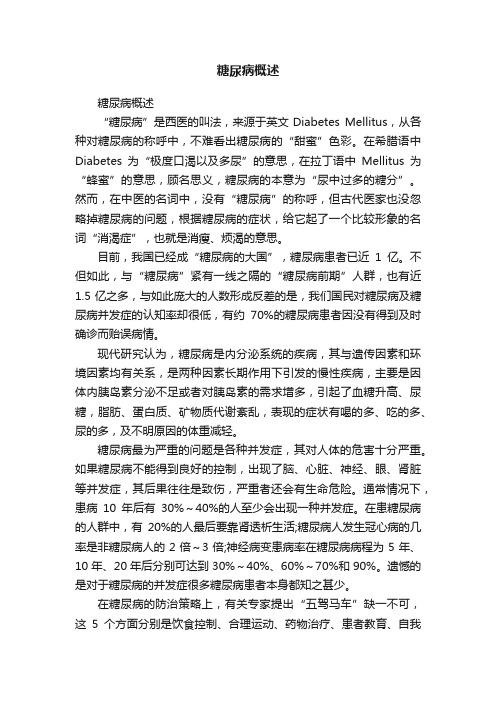
糖尿病概述糖尿病概述“糖尿病”是西医的叫法,来源于英文Diabetes Mellitus,从各种对糖尿病的称呼中,不难看出糖尿病的“甜蜜”色彩。
在希腊语中Diabetes为“极度口渴以及多尿”的意思,在拉丁语中Mellitus为“蜂蜜”的意思,顾名思义,糖尿病的本意为“尿中过多的糖分”。
然而,在中医的名词中,没有“糖尿病”的称呼,但古代医家也没忽略掉糖尿病的问题,根据糖尿病的症状,给它起了一个比较形象的名词“消渴症”,也就是消瘦、烦渴的意思。
目前,我国已经成“糖尿病的大国”,糖尿病患者已近1亿。
不但如此,与“糖尿病”紧有一线之隔的“糖尿病前期”人群,也有近1.5亿之多,与如此庞大的人数形成反差的是,我们国民对糖尿病及糖尿病并发症的认知率却很低,有约70%的糖尿病患者因没有得到及时确诊而贻误病情。
现代研究认为,糖尿病是内分泌系统的疾病,其与遗传因素和环境因素均有关系,是两种因素长期作用下引发的慢性疾病,主要是因体内胰岛素分泌不足或者对胰岛素的需求增多,引起了血糖升高、尿糖,脂肪、蛋白质、矿物质代谢紊乱,表现的症状有喝的多、吃的多、尿的多,及不明原因的体重减轻。
糖尿病最为严重的问题是各种并发症,其对人体的危害十分严重。
如果糖尿病不能得到良好的控制,出现了脑、心脏、神经、眼、肾脏等并发症,其后果往往是致伤,严重者还会有生命危险。
通常情况下,患病10年后有30%~40%的人至少会出现一种并发症。
在患糖尿病的人群中,有20%的人最后要靠肾透析生活;糖尿病人发生冠心病的几率是非糖尿病人的2倍~3倍;神经病变患病率在糖尿病病程为5年、10年、20年后分别可达到30%~40%、60%~70%和90%。
遗憾的是对于糖尿病的并发症很多糖尿病患者本身都知之甚少。
在糖尿病的防治策略上,有关专家提出“五驾马车”缺一不可,这5个方面分别是饮食控制、合理运动、药物治疗、患者教育、自我监测。
通过多种方式把血糖控制在正常范围内,减少其并发症,积极配合医生治疗,糖尿病是可以控制的。
糖尿病相关英文词汇
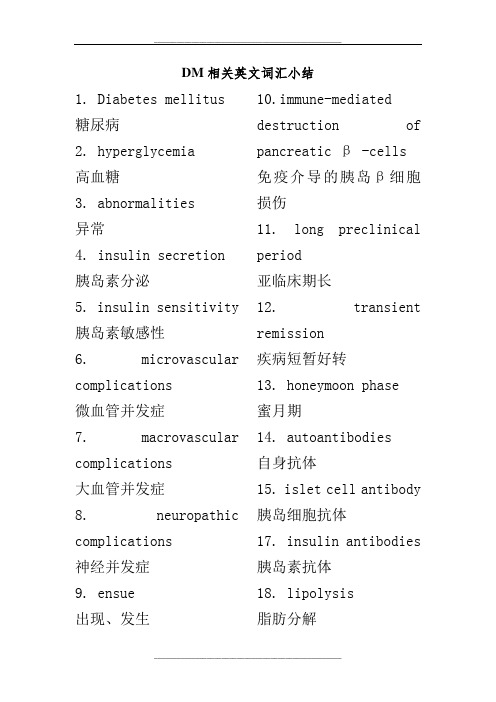
DM相关英文词汇小结1. Diabetes mellitus 糖尿病2. hyperglycemia高血糖3. abnormalities异常4. insulin secretion胰岛素分泌5. insulin sensitivity 胰岛素敏感性6. microvascular complications微血管并发症7. macrovascular complications大血管并发症8. neuropathic complications神经并发症9. ensue出现、发生10.immune-mediated destruction of pancreatic β -cells免疫介导的胰岛β细胞损伤11. long preclinical period亚临床期长12. transient remission疾病短暂好转13. honeymoon phase蜜月期14. autoantibodies自身抗体15. islet cell antibody 胰岛细胞抗体17. insulin antibodies 胰岛素抗体18. lipolysis脂肪分解19. free fatty acid production游离脂肪酸生成20. increased hepatic glucose production肝糖生成增加21.decreased skeletal muscle uptake of glucose肌肉组织对葡萄糖摄取下降22. a diabetogenic lifestyle (excessive calories, inadequate exercise, and obesity)易导致糖尿病的生活方式(能量过度摄入、锻炼不足、肥胖)23. superimposed upon 协同24. a susceptible genotype 易感基因25. glucocorticoids糖皮质激素26. pentamidine喷他脒27. niacin烟酸28. α-interferonα-干扰素29. Impaired fasting glucose,IFG空腹血糖受损(5.6–6.9 mmol/L)30. impaired glucose tolerance,IGT糖耐量受损(7.8–11.0 mmol/L)31. retinopathyDM视网膜病变32. neuropathyDM神经病变33. nephropathyDM肾病34. coronary heart disease冠心病35. stroke中风36. peripheral vascular disease外周血管病变37. prone to develop diabetic ketoacidosis 自发酮症倾向38. severe stress严重应激39. insulin counterregulatory hormones胰岛素对抗激素40. asymptomatic无症状41. unrelated blood testing 随机血糖42. Lethargy无精打采43. polyuria多尿44. nocturia夜尿45. polydipsia烦渴46. Hemoglobin A1C (glycosylated hemoglobin)糖化血红蛋白(≥6.5%为诊断标准)46. Fasting plasma glucose空腹血糖(≥126 mg/dL (7.0 mmol/L)为诊断标准)47. oral glucose tolerance test (OGTT)口服糖耐量检测48. 75 g anhydrous glucose75g无水葡萄糖(折合82.5g一水葡萄糖)49. Two-hour plasma glucose2小时血糖(≥200 mg/dL (111.1 mmol/L)为诊断标准)50. A random plasma glucose concentration 随机血糖(≥200 mg/dL (111.1 mmol/L)为诊断标准)51. hyperglycemic crisis高血糖危象52. positive family history家族史阳性53. ameliorate symptoms of hyperglycemia控制高血糖症状54. Glycemic Goals血糖控制目标55. Preprandial plasma glucose餐前血糖56. Postprandial plasma glucose餐后血糖57. American Association of Clinical Endocrinologists美国临床内分泌医师学会AACE58. American College of Endocrinology美国内分泌学会ACE59. American Diabetes Association美国糖尿病协会ADA60. aggressive management强化控制61. smoking cessation 戒烟62. treatment of dyslipidemia调节血脂异常63. intensive blood pressure强化血压控制64. antiplatelet therapy抗血小板治疗65. dietary and exercise modifications 改变饮食锻炼习惯66. self-monitoring of blood glucose (SMBG)自我血糖监测67. low in saturated fat 饱和脂肪限量68. caloricrestriction控制热量69. Bedtime and between meal snacks睡前及餐间零食70. Aerobic exercise有氧锻炼71. sedentary patients 既往运动较少的病人72. atherosclerotic disease动脉粥样硬化疾病73. subcutaneously皮下注射74. Humalog (insulin lispro)赖脯胰岛素(优泌乐®)75. NovoLog (insulin aspart)门冬胰岛素(诺和锐®)76. Apidra (insulin glulisine)赖谷胰岛素(Apidra®,目前还没有中文名)77. Rapid-acting insulins速效胰岛素78. Short-acting insulins短效胰岛素79. Humulin R (regular)优泌林®R80. Novolin R (regular)诺和灵®R81.Intermediate-acting insulins (neutral protamine Hagedorn)中效胰岛素(中性鱼精蛋白胰岛素,NPH)Hagedorn为发明者名字82. Humulin N 优泌林®N83. Novolin N诺和灵®N84. Long-acting insulins长效胰岛素85. Lantus (insulin glargine)来得时®(甘精胰岛素)86. Levemir (insulin detemir)诺和平®(地特胰岛素)87. Premixed insulins 预混胰岛素88. Humalog Mix 75/25 (75% neutral protamine lispro,25% lispro)优泌乐®MIX75/25(75%鱼精蛋白赖脯胰岛素;25%赖脯胰岛素)89. Humalog Mix 50/50 (50% neutral protaminelispro,50% lispro)优泌乐®MIX50/50(50%中性鱼精蛋白赖脯胰岛素;50%赖脯胰岛素)90. Novolog Mix 70/30 (70% aspart protamine suspension, 30% aspart)阿福特罗诺和锐®MIX70/30(70%鱼精蛋白门冬胰岛素;30%门冬胰岛素)91.NPH-regular combinations中效-短效组合92. Humulin 70/30优泌林®70/3093. Novolin 70/30诺和灵®70/3094. Exenatide (Byetta)艾塞那肽(百泌达)GLP-1 95. Liraglutide (Victoza)利拉鲁肽(诺和力)96. Pramlintide (Symlin)普兰林肽(人胰淀素类似物)97. delayed postmeal hypoglycemia迟发性餐后低血糖98. nocturnal hypoglycemia夜间低血糖99. fasting hyperglycemia空腹高血糖100. Glucagon (1 g intramuscularly)胰高血糖素(肌肉注射)101. Glucagon-like Peptide 1 (GLP-1) Agonists胰高血糖素样肽1激动剂102. gastric emptying胃排空103. Sulfonylureas磺脲类104. equipotent doses 等效剂量105. Glipizide格列吡嗪(普通片,控释片(XL)瑞易宁®)106. glyburide格列本脲(普通片:Diabeta®,优降糖®;微乳制剂:Micron ase®)107. Glimepiride格列美脲(Amaryl®,亚莫利®)108. Short-acting insulin secretagogues 短效胰岛素促泌剂(餐时促泌剂)109. Nateglinide那格列奈(Starlix®,唐力®)110. Repaglinide瑞格列奈(Prandin®,孚来迪®)111. Biguanides双胍类112. Metformin二甲双胍(格华止®,Glucophage®)113. Metformin extended release二甲双胍缓释片(格华止®,Glucophage XR ®)114. Thiazolidinediones噻唑烷二酮类115. Pioglitazone吡格列酮(艾可拓®,Actos®)116. Rosiglitazone 罗格列酮(文迪雅®,Avandia®)117. α-Glucosidaseinhibitorsα-糖苷酶抑制剂118. Acarbose阿卡波糖(拜糖平®,Precose®)119. Miglitol米格列酮(Glyset®)120. Dipeptidyl peptidase-4 (DPP-4) inhibitors二肽基转肽酶-4抑制剂121. Sitagliptin西格列汀(捷诺维®,Januvia®)122. Saxagliptin沙格列汀(安立泽®,Onglyza®)123.Glyburide/metformin 格列本脲/二甲双胍(Glucovance®)124. Glipizide/metformin (N) Metaglip格列吡嗪/二甲双胍(Metaglip®)125.Rosiglitazone/metformin罗格列酮/二甲双胍(文达敏®,Avandamet®)126. long half-life drugs长半衰期药物127. skip meals,误餐128. exercise vigorously高强度锻炼129. skin rash皮疹130. hemolytic anemia溶血性贫血131. GI upset胃肠道不适132. cholestasis胆汁淤积133. Hyponatremia低钠血症134. glucose dependent insulin release葡萄糖依赖的胰岛素释放(格列奈类)135. the medication should also be skipped 误餐,当餐药物也无需服用136. insulin-sensitive tissues胰岛素敏感组织137. hepatic and peripheral (muscle) tissues肝脏及外周(肌肉)组织138. basal-bolus therapy 基础联合餐时胰岛素方案136. glycemiclability.血糖不稳定137. preprandial SMBG level餐前血糖监测水平138. upcoming activity level未来运动量139. anticipated carbohydrate intake预计摄食水平140. Carbohydrate counting碳水化合物计量141. diminish aggregation减少聚集142. greater glycemic control严格控制血糖143. erratic postprandial control 餐后血糖控制不佳144. judiciously titrated based on GI adverse effects and postprandial glycemic goals根据胃肠道不良反应及血糖控制水平调整剂量145. Symptomatic patients有症状的患者146. worsen insulin resistance加重胰岛素抵抗147. therapeutic lifestyle measures治疗性生活方式改善148. Obese patients (>120% ideal body weight)肥胖患者(标准体重120%)149.Near-normal-weight patients体重基本正常的患者150. disease progresses on metformin therapy应用二甲双胍期间病情进展151. on multiple therapies正在应用多种治疗方案152. bedtime injection 晚间(胰岛素)注射153. Intensify management强化治疗方案154. Less intensive management非强化治疗方案155. intact hypoglycemia awareness 有低血糖症状(未受损伤)156. used at the discretion of the clinician在医师的监护下用药157. ophthalmologist 眼科医生158. regress恢复159. Laser photocoagulation激光光凝治疗160. Paresthesias感觉异常161. numbness麻木162. predominant symptoms 主要症状163. tricyclic antidepressants,三环类抗抑郁药物164. anticonvulsants 抗惊厥的药165. gabapentin加巴喷丁166. pregabalin普瑞巴林167. carbamazepine卡巴咪嗪168. topiramate托吡酯169. duloxetine,度洛西汀170. venlafaxine,文拉法辛171. topical capsaicin 辣椒素(表面应用)172. analgesics止痛药173. tramadol曲马多174. Gastroparesis胃瘫175. Erythromycin红霉素176. debilitating使人虚弱的177. metoclopramide甲氧氯普胺178. orthostatic hypotension体位性低血压179. mineralocorticoids盐皮质激素180. Diabetic diarrhea 糖尿病腹泻181. nocturnal夜间(五更泻)182. doxycycline多西环素183. metronidazole甲硝唑184. Octreotide奥曲肽185. Erectile dysfunction勃起功能障碍186. sildenafil西地那非187. vardenafil伐地那非188. tadalafil他达那非189. retarding the progression of established nephropathy延缓神经病变进程190. Diuretics利尿剂191. volume-expanded states容量增加状态192. Claudication跛行193. correction of dyslipidemia纠正血脂异常194. antiplatelet therapy抗血小板治疗195. Cilostazol西洛他唑(Pletal®) 196. select patients 选定的病人197. Local debridement 去死皮198. The National Cholesterol Education Program Adult Treatment Panel III Guidelines国际胆固醇教育项目成人治疗专家指南200. Niacin烟酸201.fibrate贝特类药物202. polyuria多尿203.polydipsia多饮,烦渴204. Finer insulin adjustments更为精细的血糖调节205. nocturnal sweating夜汗206.palpitations心悸207. microalbuminuria 微量白蛋白尿208. albuminuria白蛋白尿209. dilated ophthalmologic exams散瞳查眼底210. influenza and pneumococcal vaccine 流感及肺炎疫苗。
糖尿病英文文章
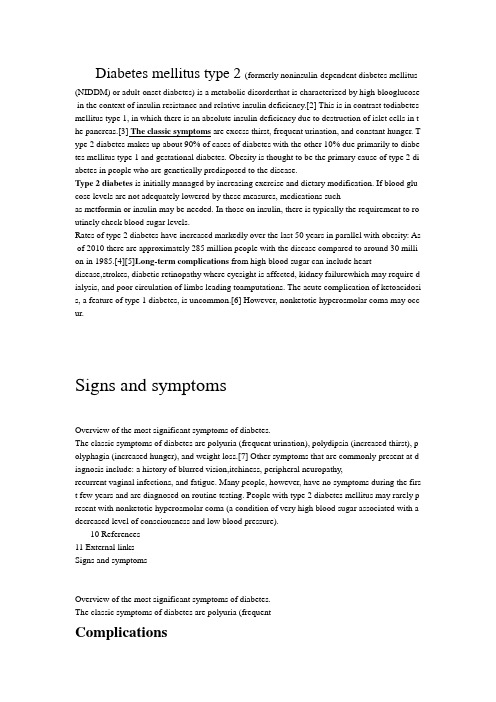
Diabetes mellitus type 2 (formerly noninsulin-dependent diabetes mellitus (NIDDM) or adult-onset diabetes) is a metabolic disorderthat is characterized by high blooglucose in the context of insulin resistance and relative insulin deficiency.[2] This is in contrast todiabetes mellitus type 1, in which there is an absolute insulin deficiency due to destruction of islet cells in t he pancreas.[3] The classic symptoms are excess thirst, frequent urination, and constant hunger. T ype 2 diabetes makes up about 90% of cases of diabetes with the other 10% due primarily to diabe tes mellitus type 1 and gestational diabetes. Obesity is thought to be the primary cause of type 2 di abetes in people who are genetically predisposed to the disease.Type 2 diabetes is initially managed by increasing exercise and dietary modification. If blood glu cose levels are not adequately lowered by these measures, medications suchas metformin or insulin may be needed. In those on insulin, there is typically the requirement to ro utinely check blood sugar levels.Rates of type 2 diabetes have increased markedly over the last 50 years in parallel with obesity: As of 2010 there are approximately 285 million people with the disease compared to around 30 milli on in 1985.[4][5]Long-term complications from high blood sugar can include heart disease,strokes, diabetic retinopathy where eyesight is affected, kidney failurewhich may require d ialysis, and poor circulation of limbs leading toamputations. The acute complication of ketoacidosi s, a feature of type 1 diabetes, is uncommon.[6] However, nonketotic hyperosmolar coma may occ ur.Signs and symptomsOverview of the most significant symptoms of diabetes.The classic symptoms of diabetes are polyuria (frequent urination), polydipsia (increased thirst), p olyphagia (increased hunger), and weight loss.[7] Other symptoms that are commonly present at d iagnosis include: a history of blurred vision,itchiness, peripheral neuropathy,recurrent vaginal infections, and fatigue. Many people, however, have no symptoms during the firs t few years and are diagnosed on routine testing. People with type 2 diabetes mellitus may rarely p resent with nonketotic hyperosmolar coma (a condition of very high blood sugar associated with a decreased level of consciousness and low blood pressure).10 References11 External linksSigns and symptomsOverview of the most significant symptoms of diabetes.The classic symptoms of diabetes are polyuria (frequentComplicationsMain article: Complications of diabetes mellitusType 2 diabetes is typically a chronic disease associated with a ten-year-shorter life expectancy.[4] This is partly due to a number of complications with which it is associated, includi ng: two to four times the risk of cardiovascular disease, includingischemic heart disease and stroke ; a 20-fold increase in lower limb amputations, and increased rates of hospitalizations.[4] In the de veloped world, and increasingly elsewhere, type 2 diabetes is the largest cause of nontraumatic blindnessand kidney failure.[8] It has also been associated with an increased risk of cognitive dysfunction and dementiathrough disease processes such as Alzheimer'disease and vascu lar dementia.[9] Other complications include:acanthosis nigricans, sexual dysfunction, and freque nt infections.[7]causeThe development of type 2 diabetes is caused by a combination of lifestyle and genetic factors.[8][ 10] While some are under personal control, such as diet and obesity, others, such as increasing age , female gender, and genetics, are not.[4] A lack of sleep has been linked to type 2 diabetes.[11] Th is is believed to act through its effect on metabolism.[11] The nutritional status of a mother during fetal development may also play a role, with one proposed mechanism being that of altered DNA methylationgeneticThere are a number of rare cases of diabetes that arise due to an abnormality in a single gen e (known asmonogenic forms of diabetes or "other specific types of diabetes").[3][4] These in clude maturity onset diabetes of the young (MODY), Donohue syndrome,and Rabson-Mendenhall syndrome, among others.[4] Maturity onset diabetes of the young c onstitute 1–5% of all cases of diabetes in young people.[18]Medical conditionsThere are a number of medications and other health problems that can predispose to diabetes.[19] Some of the medications include: glucocorticoids, thiazides, beta blockers, atyp ical antipsychotics,[20] andstatins.[21]Those who have previously had gestational diabetes ar e at a higher risk of developing type 2 diabetes.[7] Other health problems that are associated include: acromegaly, Cushing's syndrome, hyperthyroidism,pheochromocytoma, and certain cancers such as glucagonomas.[19] Testosterone deficiency is also associated with typ e 2 diabetes.[22][23]PathophysiologyType 2 diabetes is due to insufficient insulin production from beta cells in the setting of insuli n resistance.[3] Insulin resistance, which is the inability of cells to respond adequately to nor mal levels of insulin, occurs primarily within the muscles, liver, and fat tissue.[24] In the liver , insulin normally suppresses glucose release. However, in the setting of insulin resistance, th e liver inappropriately releases glucose into the blood.[4] The proportion of insulin resistance versus beta cell dysfunction differs among individuals, with some having primarily insulin resistance and only a minor defect in insulin secretion and others with slight insulin resistance and primarily a lack of insulin secretion.[3] Other potentially important mechanisms associ ated with type 2 diabetes and insulin resistance include: increased breakdown of lipids withi n fat cells, resistance to and lack of incretin, high glucagon levels in the blood, increased rete ntion of salt and water by the kidneys, and inappropriate regulation of metabolism by thecen tral nervous system.[4] However, not all people with insulin resistance develop diabetes, sinc e an impairment of insulin secretion by pancreatic beta cells is also required.[3] DiagnosisThe World Health Organizationdefinition of diabetes (both type 1 and type 2) is for a single raised glucose reading with symptoms, otherwise raised values on two occasions, of either:[2 7]fasting plasma glucose ≥ 7.0 mmol/l (126 mg/dl) orwith a glucose tolerance test, two hours after the oral dose a plasma glucose ≥ 11.1 mmol/ l(200 mg/dl)A random blood sugar of greater than 11.1 mmol/l (200 mg/dL) in association with typical sy mptoms[7] or aglycated hemoglobin (HbA1c) of greater than 6.5% is another method of diag nosing diabetes.[4] In 2009 an International Expert Committee that included representatives of the American Diabetes Association (ADA), the International Diabetes Federation (IDF), a nd the European Association for the Study of Diabetes (EASD) recommended that a threshold of ≥6.5% HbA1c should be used to diagnose diabetes. This recommendation was adopted by the American Diabetes Association in 2010.[28] Positive tests should be repeated unless the perso n presents with typical symptoms and blood sugars >11.1 mmol/l (>200 mg/dl).[29] Threshold for diagnosis of diabetes is based on the relationship between results of glucose tol erance tests, fasting glucose or HbA1c and complications such as retinal problems.[4] A fasti ng or random blood sugar is preferred over the glucose tolerance test, as they are more conv enient for people.[4] HbA1c has the advantages that fasting is not required and results are m ore stable but has the disadvantage that the test is more costly than measurement of blood gl ucose.[30] It is estimated that 20% of people with diabetes in the United States do not realize that they have the disease.[4]Diabetes mellitus type 2 is characterized by high blood glucose in the context of insulin resist ance and relative insulin deficiency.[2] This is in contrast to diabetes mellitus type 1 in which there is an absolute insulin deficiency due to destruction of islet cells inthe pancreas and gestational diabetes mellitus that is a new onset of high blood sugars in ass ociated with pregnancy.[3] Type 1 and type 2 diabetes can typically be distinguished based o n the presenting circumstances.[29] If the diagnosis is in doubt antibody testing may be useful to confirm type 1 diabetes and C-peptide levels may be useful to confirm type 2 diabetes,[31] with C-peptide levels normal or high in type 2 diabetes, but low in type 1 diabet es.ScreeningNo major organization recommends universal screening for diabetes as there is no evidence t hat such a program would improve outcomes.[32] Screening is recommended by the United States Preventive Services Task Force in adults without symptoms whose blood pressure is gr eater than 135/80 mmHg.[33] For those whose blood pressure is less, the evidence is insuffici ent to recommend for or against screening.[33] The World Health Organizationrecommends only testing those groups at high risk.[32] High-risk groups in the United States include: those over 45 years old; those with a first degree relative with diabetes ; some ethnic groups, including Hispanics, African-Americans, and Native-Americans; a hist oryof gestational diabetes; polycystic ovary syndrome; excess weight; and conditions associated with metabolic syndrome.[7]PreventionMain article: Prevention of diabetes mellitus type 2Onset of type 2 diabetes can be delayed or prevented through proper nutrition and regular e xercise.[34][35]Intensive lifestyle measures may reduce the risk by over half.[8] The benefit o f exercise occurs regardless of the person's initial weight or subsequent weight loss.[36] Evid ence for the benefit of dietary changes alone, however, is limited,[37] with some evidence for a diet high in green leafy vegetables[38] and some for limiting the intake of sugary drinks.[13 ] In those with impaired glucose tolerance, diet and exercise either alone or in combination w ith metformin or acarbose may decrease the risk of developing diabetes.[8][39] Lifestyle inte rventions are more effective than metformin.[8]entionMain article: Prevention of diabetes mellitus type 2Onset of type 2 diabetes can be delayed or prevented through proper nutrition and regular exercise .[34][35]Intensive lifestyle measures may reduce the risk by over half.[8] The benefit of exercise o ccurs regardless of the person's initial weight or subsequent weight loss.[36] Evidence for the bene fit of dietary changes alone, however, is limited,[37] with some evidence for a diet high in green le afy vegetables[38] and some for limiting the intake of sugary drinks.[13] In those with impaired gl ucose tolerance, diet and exercise either alone or in combination with metformin or acarbose may decrease the risk of developing diabetes.[8][39] Lifestyle interventions are more effective than met formin.[8]ManagementFurther information: Diabetes managementManagement of type 2 diabetes focuses on lifestyle interventions, lowering other cardiovascularrisk factors, and maintaining blood glucose levels in the normalrange.[8] Self-monitoring of blood glucose for people with newly diagnosed type 2 diabetes was r ecommended by the British National Health Service in 2008,[40] however the benefit of self moni toring in those not using multi-dose insulin is questionable.[8][41] Managing other cardiovascular risk factors, such as hypertension, high cholesterol, and microalbuminuria, improves a person's lif e expectancy.[8] Intensive blood pressure management (less than 130/80 mmHg) as opposed to sta ndard blood pressure management (less than140–160/85–100 mmHg) results in a slight decrease in stroke risk but no effect on overall risk of death.[42] Intensive blood sugar lowering (HbA1c<6%) as opposed to standard blood sugar lowering (HbA1c of 7–7.9%) does not appear to change mortality.[43][44] The goal of treatment is typically an HbA1c of less than 7% or a fasting glucose of less than 6.7 mmol/L (120 mg/dL) however these goals may b e changed after professional clinical consultation, taking into account particular risks of hypoglyce mia and life expectancy.[7] It is recommended that all people with type 2 diabetes get regular opht halmology examination.[3]LifestyleA proper diet and exercise are the foundations of diabetic care,[7] with a greater amount of e xercise yielding better results.[45] Aerobic exercise leads to a decrease in HbA1c and improv ed insulin sensitivity.[45]Resistance training is also useful and the combination of both types ofexercise may be most effective.[45] Adiabetic diet that promotes weight loss is important.[46] While the best diet type to achieve this is controversial[46] a low glycemic index diet has been found to improve blood sugar control.[47] Culturally appropriate education may help people with type 2 diabetes control their blood sugar levels, for up to six months at least.[48] If ch anges in lifestyle in those with mild diabetes has not resulted in improved blood sugars within six weeks, medications should then be considered.[7]MedicationsMetformin 500mg tabletsThere are several classes of anti-diabetic medications available. Metforminis generally recommen ded as a first line treatment as there is some evidence that it decreases mortality.[8] A second oral agent of another class may be used if metformin is not sufficient.[49] Other classes of medications include: sulfonylureas, nonsulfonylurea secretagogues, alpha glucosidase inhibitors, thiazolidined iones, glucagon-like peptide-1 analog, anddipeptidyl peptidase-4 inhibitors.[8][50] Metformin sho uld not be used in those with severe kidney or liver problems.[7] Injections of insulin may either be added to oral medication or used alone.[8]Most people do not initially need insulin.[3] When it is used, a long-acting formulation is typically added at night, with oral medications being continued.[7][8] Doses are then increased to effect (bl ood sugar levels being well controlled).[8] When nightly insulin is insufficient twice daily insulin may achieve better control.[7] The long acting insulins, glargine and detemir, do not appear much better than neutral protamine Hagedorn (NPH) insulin but have a significantly greater cost making them, as of 2010, not cost effective.[51] In those who are pregnant insulin is generally the treatme nt of choice.[7]SurgeryWeight loss surgery in those who are obese is an effective measure to treat diabetes.[52] Many are able to maintain normal blood sugar levels with little or no medications followingsurgery[53] and long term mortality is decreased.[54] There however is some short term mortality risk of less than 1% from the surgery.[55] The body mass index cutoffs for when surgery is approp riate are not yet clear.[54] It however is recommended that this option be considered in those who are unable to get both their weight and blood sugar under control.[56]Prevalence of diabetes worldwide in 2000 (per 1000 inhabitants). World average was 2.8%. Globally as of 2010 it was estimated that there were 285 million people with type 2 diabetes maki ng up about 90% of diabetes cases.[4] This is equivalent to about 6% of the world's adult populati on.[57] Diabetes is common both in the developed and the developing world.[4] It remains uncom mon, however, in the underdeveloped world.[3]Women seem to be at a greater risk as do certain ethnic groups,[4][58] such as South Asians, Pacif ic Islanders, Latinos, and Native Americans.[7] This may be due to enhanced sensitivity to a Weste rn lifestyle in certain ethnic groups.[59] Traditionally considered a disease of adults, type 2 diabete s is increasingly diagnosed in children in parallel withrising obesity rates.[4]Type 2 diabetes is now diagnosed as frequently as type 1 diabetes in teenage rs in the United States.[3]Rates of diabetes in 1985 were estimated at 30 million, increasing to 135 million in 1995 and 217 million in 2005.[5] This increase is believed to be primarily due to the global population aging, a d ecrease in exercise, and increasing rates of obesity.[5] The five countries with the greatest number of people with diabetes as of 2000 are India having 31.7 million, China 20.8 million, the United St ates 17.7 million, Indonesia 8.4 million, and Japan 6.8 million.[60] It is recognized as a global epi demic by the World Health Organization.[61]后面的这个比较简单大白话,-----What is DiabetesIf you have found your way to this page it is probably because you are searching for everything th ere is to know about diabetes. Knowledge is power. You have questions and you need answers to h ave power over this chronic disease.The diseases which are listed under Diabetes Mellitus are many with the most common being Typ e-1 diabetes and Type-2 diabetes. These are diseases of the metabolic system and involve the body 's ability in metabolizing sugar using the hormone insulin. Insulin helps the cells use the simple su gar glucose which is needed for repair, growth and energy.In Type-1 diabetes, the body produces little or no insulin so those with this type of diabetes need t o be on insulin therapy for their entire lives. Before 1924 Type-1 diabetes usually ended with dead after a couple of years but with the advent of insulin those who have this disease are now able to manage this chronic condition. Type-1 diabetes is also known as juvenile diabetes because those w ho have this type of diabetes are usually diagnosed with it between the ages of 9 and 15 years of a ge.With Type-2 diabetes, the body produces plenty of insulin but cells are unable to use it. This type of diabetes is the most common form of diabetes and although it used to normally develop in olde r adults, Type 2 diabetes is now developing at all ages. Major risk factors for Type-2 diabetes are u nhealthy diets, little or no exercise and being overweight or obese. There is currently a world wide epidemic of Type-2 diabetes which researchers believe is being driven in many areas because of s edentary life styles revolving around computers, video games, television and fast foods. Fast food restaurants are now in every corner of ourworld.Diabetes in the USCurrently in the United States 7.8% of the population or around 23.6 million people have diabetes with 5.7 million being undiagnosed. Most of those diagnosed have Type-2 diabetes and are usually 45 years of age or older. But this snapshot is changing as more children and adolescents are increa singly being diagnosed with this type of diabetes.Studies show that the most common complication of Type-2 diabetes is cardiovascular and it is als o the most costly complication at a cost of approximately $7 billion of the $44 billion annual direct medical costs for diabetes. This figure is from 1997 and many estimate that these figures could h ave doubled by now.Diabetes in IndiaAs of 2000 it was estimated that 171 million people globally suffered from diabetes or 2.8% of the population. Type-2 diabetes is the most common type worldwide.Figures for the year 2007 show that the 5 countries with the largest amount of people diagnosed w ith diabetes were India (40.9 million), China (38.9 million), US (19.2 million), Russia (9.6 million ), and Germany (7.4 million).Currently, India is the diabetes capital of the world. It is estimated that over 40 million of those wit h diabetes are currently in India and that by 2025 that number will grow to 70 million. In other wo rds, 1 in every 5 diabetics in the world will live in India. Diabetes is the number one cause of kidn ey failure, is responsible for 5% of blindness in adults and 1 million limb amputations. Because of the chronic nature of diabetes, the relentlessness of its complications and the means re quired to control both diabetes and its complications; this disease is very costly, not only for affect ed individuals and families but also for the healthcare systems. Studies done in India estimate that for a low income family with an adult having diabetes, as much as 25% of the family's income ma y need to be devoted to diabetes care.Stress also seems to be a greater risk factor in India for diabetes. It is important to de-stress accord ing to each one's disposition - for example spending quality time with friends and family, Yoga, br eathing exercises, walking, meditation, aerobics and other fitness regimen can ward off diabetes.Preliminary findings of a recent study in India among school children in the higher socio-economi c group in Chennai showed child obesity is growing higher and girlswere found to be disproportionately "heavier" than boys.Stopping the EpidemicIt is really fairly simple - medical professionals believe that turning off the TV and computer and g oing outside to walk or exercise will go a long way to stopping this epidemic. Other suggestions in clude cutting calories in diets, snacking on whole grain and high-fiber foods, avoiding smoking an d alcohol, exercising regularly and getting stress levels under control are pro-active ways to keep t his diabetic epidemic from continuing to grow.。
糖尿病(diabetes mellitus)

(四)胰岛素治疗 1.适应症:1型DM;糖尿病酮症酸中毒,高 渗性昏迷和乳酸性酸中毒;各种严重的糖尿 病急性或慢性并发症;消耗性疾病;围手术 期;妊娠和分娩;2型DM口服降糖药效果不 满意者;全胰腺切除者。
2.制剂类型
动物胰岛素 人胰岛素 胰岛素类似物 短效、中效、长效、预混。
各种胰岛素的特点
服药次数 作用时间 肾排泄 次/日 h %
1~2 1~2 1~2 1 ~3 1 10 ~ 20 16 ~ 24 12 ~ 24 12~ 24 50 89 80 5 60
格列本脲 格列吡嗪 格列齐特 格列喹酮 格列美脲
2.双胍类:改善外周组织对胰岛素的敏感性,增加外 周组织对葡萄糖的摄取和利用;抑制肝葡萄糖输出; 减肥。 常用药物:二甲双胍 0.5~1.5g/d,分2~ 3次服用 禁忌证: 禁忌证 肾、肝、心、肺功能减退以及高热患者、 慢性胃肠病、慢性营养不良、消瘦者; T1DM不宜单 独使用; T2DM合并急性代谢紊乱、感染、外伤、手 术、孕妇、哺乳期妇女;对药物过敏或有严重不良反 应者;酗酒者;使用碘造影剂前后 副作用:胃肠道反应,皮疹,乳酸性酸中毒 副作用
三、病因与发病机制 1型糖尿病 环境因素 ↓诱发因素 遗传易感性→自身免疫反应→自身抗体 →β细胞功能损伤至衰竭→DM
2型糖尿病 环 境 因 素 ↓ 遗传易感性→IR及分泌缺陷→IGT/IFG→DM
胰岛素抵抗(IR)
胰岛素作用的靶器官(主要是肝脏、肌肉和 脂肪组织)对胰岛素作用的敏感性降低。 胰岛素降低血糖的主要机制包括抑制肝脏葡 萄糖产生(HGP)、刺激内脏组织(肝和胃 肠道)对葡萄 糖的摄取以及外周组织(骨骼 肌、脂肪)对葡萄糖的利用。
糖尿病 (diabetes mellitus)
一、概述
糖尿病相关单词
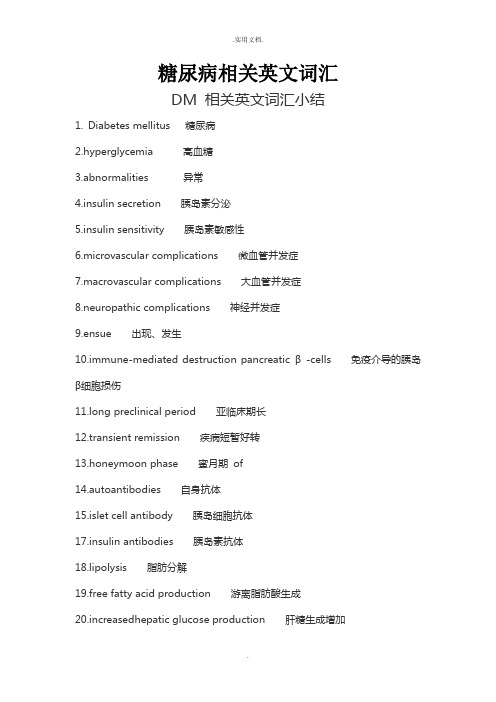
糖尿病相关英文词汇DM 相关英文词汇小结1.Diabetes mellitus 糖尿病2.hyperglycemia 高血糖3.abnormalities 异常4.insulin secretion 胰岛素分泌5.insulin sensitivity 胰岛素敏感性6.microvascular complications 微血管并发症7.macrovascular complications 大血管并发症8.neuropathic complications 神经并发症9.ensue 出现、发生10.immune-mediated destruction pancreatic β-cells 免疫介导的胰岛β细胞损伤11.long preclinical period 亚临床期长12.transient remission 疾病短暂好转13.honeymoon phase 蜜月期of14.autoantibodies 自身抗体15.islet cell antibody 胰岛细胞抗体17.insulin antibodies 胰岛素抗体18.lipolysis 脂肪分解19.free fatty acid production 游离脂肪酸生成20.increasedhepatic glucose production 肝糖生成增加21.decreased skeletal muscle uptake of glucose 肌肉组织对葡萄糖摄取下降22.adiabetogenic lifestyle (excessive calories, inadequate exercise, and obesity) 易导致糖尿病的生活方式〔能量过度摄入、锻炼缺乏、肥胖〕23.superimposed upon 协同24.asusceptible genotype 易感基因25.glucocorticoids 糖皮质激素26.pentamidine 喷他脒27.niacin 医学英文词汇小结-ENDO128.α-interferon α-干扰素29.Impaired fasting glucose,IFG 空腹血糖受损〔5.6–6.9 mmol/L〕30.impaired glucose tolerance,IGT 糖耐量受损〔7.8–11.40 mmol/L〕31.retinopathy DM 视网膜病变32.neuropathy DM 神经病变33.nephropathy DM 肾病34.coronary heart disease 冠心病35.stroke 中风36.peripheral vascular disease 外周血管病变37.prone to developdiabetic ketoacidosis 自发酮症倾向38.severestress 严重应激39.insulincounterregulatory hormones 胰岛素对抗激素40.asymptomatic 无病症41.unrelated blood testing 随机血糖42.Lethargy 无精打采43.polyuria 多尿44.nocturia 夜尿45.polydipsia 烦渴46.Hemoglobin A1C 〔glycosylated hemoglobin〕糖化血红蛋白〔≥6.5%为诊断标准〕46.Fasting plasma glucose 空腹血糖〔≥126 mg/dL (7.0 mmol/L)为诊断标准〕47.oralglucose tolerance test (OGTT) 口服糖耐量检测48.75 g anhydrous glucose 75g 无水葡萄糖〔折合82.5g 一水葡萄糖〕49.Two-hour plasma glucose 2 小时血糖〔≥200 mg/dL (111.1 mmol/L) 为诊断标准〕50.A random plasma glucose concentration 随机血糖〔≥200 mg/dL (111.1 mmol/L)为诊断标准〕51.hyperglycemic crisis 高血糖危象52.positivefamily history 家族史阳性53.ameliorate symptoms of hyperglycemia 控制高血糖病症54.Glycemic Goals 医学英文词汇小结-ENDO1 血糖控制目标55.Preprandial plasma glucose 餐前血糖56.Postprandial plasma glucose 餐后血糖57.American Association of Clinical Endocrinologists 美国临床内分泌医师学会AACE58. American College of Endocrinology 美国内分泌学会ACE59.American Diabetes Association 美国糖尿病协会ADA60.aggressive management 强化控制61.smoking cessation 戒烟62.treatment of dyslipidemia 调节血脂异常63.intensiveblood pressure 强化血压控制64.antiplatelet therapy 抗血小板治疗65.dietary and exercise modifications 改变饮食锻炼习惯66.self-monitoring of blood glucose (SMBG) 自我血糖监测67.low in saturated fat 饱和脂肪限量68.caloric restriction 控制热量69.Bedtime and betweenmealsnacks 睡前及餐间零食70.Aerobic exercise 有氧锻炼71.sedentary patients 既往运动较少的病人72.atherosclerotic disease 动脉粥样硬化疾病73.subcutaneously 皮下注射74.Humalog (insulin lispro) 赖脯胰岛素〔优泌乐?〕75.NovoLog (insulin aspart) 门冬胰岛素〔诺和锐?〕76.Apidra (insulin glulisine) 赖谷胰岛素〔Apidra?,目前还没有中文名〕77.Rapid-acting insulins 速效胰岛素78.Short-acting insulins 短效胰岛素79.Humulin R (regular) 优泌林?R80.Novolin R (regular) 诺和灵?R81.Intermediate-acting insulins (neutral protamine Hagedorn) 中效胰岛素〔中性鱼精蛋白胰岛素, NPH〕Hagedorn为创造者名字82.Humulin N 医学英文词汇小结-ENDO1 优泌林?N83.Novolin N 诺和灵?N84.Long-acting insulins 长效胰岛素ntus (insulin glargine) 来得时?〔甘精胰岛素〕86.Levemir (insulin detemir) 诺和平?〔地特胰岛素〕87.Premixed insulins 预混胰岛素88.Humalog Mix 75/25 (75%neutral protamine lispro,25% lispro) 优泌乐?MIX75/25〔75%鱼精蛋白赖脯胰岛素;25%赖脯胰岛素〕89.Humalog Mix 50/50 (50%neutral protamine lispro,50% lispro) 优泌乐?MIX50/50〔50%中性鱼精蛋白赖脯胰岛素;50%赖脯胰岛素〕90.Novolog Mix 70/30 (70% aspart protamine suspension, 30% aspart)阿福特罗诺和锐?MIX70/30(70%鱼精蛋白门冬胰岛素;30%门冬胰岛素)91.NPH-regular combinations 中效-短效组合92.Humulin 70/30 优泌林?70/3093.Novolin 70/30 诺和灵?70/3094.Exenatide (Byetta) 艾塞那肽〔百泌达〕GLP-195.Liraglutide (Victoza) 利拉鲁肽〔诺和力〕96.Pramlintide (Symlin) 普兰林肽〔人胰淀素类似物〕97.delayedpostmealhypoglycemia 迟发性餐后低血糖98.nocturnal hypoglycemia 夜间低血糖99.fasting hyperglycemia 空腹高血糖100.Glucagon 〔1 g intramuscularly〕胰高血糖素〔肌肉注射〕101.Glucagon-like Peptide 1 (GLP-1)Agonists 胰高血糖素样肽1冲动剂102.gastric emptying 胃排空103.Sulfonylureas 磺脲类104.equipotent doses 等效剂量105.Glipizide 格列吡嗪〔普通片,控释片〔XL〕瑞易宁?〕106.glyburide 格列本脲〔普通片:Diabeta?,优降糖?;微乳制剂:Micronase?〕107.Glimepiride 格列美脲(Amaryl?,亚莫利?)108.Short-acting insulin secretagogues 短效胰岛素促泌剂〔餐时促泌剂〕医学英文词汇小结-ENDO1109.Nateglinide 那格列奈〔Starlix?,唐力?〕110.Repaglinide 瑞格列奈〔Prandin?,孚来迪?〕111.Biguanides 双胍类112.Metformin 二甲双胍〔格华止?,Glucophage?〕113.Metformin extendedrelease 二甲双胍缓释片〔格华止?,Glucophage XR ?〕114.Thiazolidinediones 噻唑烷二酮类115.Pioglitazone 吡格列酮〔艾可拓?,Actos?〕116.Rosiglitazone 罗格列酮〔文迪雅?,Avandia?〕117.α-Glucosidase inhibitors α-糖苷酶抑制剂118.Acarbose 阿卡波糖〔拜糖平?,Precose?〕119.Miglitol 米格列酮〔Glyset?〕120.Dipeptidyl peptidase-4 (DPP-4) inhibitors 二肽基转肽酶-4抑制剂121.Sitagliptin 西格列汀〔捷诺维?,Januvia?〕122.Saxagliptin 沙格列汀〔安立泽?,Onglyza?〕123.Glyburide/metformin 格列本脲/二甲双胍〔Glucovance?〕124.Glipizide/metformin (N) Metaglip 格列吡嗪/二甲双胍〔Metaglip?〕125.Rosiglitazone/metformin 罗格列酮/二甲双胍〔文达敏?, Avandamet?〕126.long half-life drugs 长半衰期药物127.skip meals, 误餐128.exercise vigorously 高强度锻炼129.skin rash 皮疹130.hemolytic anemia 溶血性贫血131.GI upset 胃肠道不适132.cholestasis 胆汁淤积133.Hyponatremia 低钠血症134.glucose dependentinsulin release 葡萄糖依赖的胰岛素释放〔格列奈类〕135.the medication should alsobe skipped 误餐,当餐药物也无需服用136.insulin-sensitive tissues 胰岛素敏感组织137.hepatic and peripheral (muscle) tissues 医学英文词汇小结-ENDO1 肝脏及外周〔肌肉〕组织138.basal-bolus therapy 根底联合餐时胰岛素方案136.glycemic lability. 血糖不稳定137.preprandial SMBGlevel 餐前血糖监测水平138.upcoming activity level 未来运动量139.anticipated carbohydrate intake 预计摄食水平140.Carbohydrate counting 碳水化合物计量141.diminish aggregation 减少聚集142.greater glycemic control 严格控制血糖143.erratic postprandial control 餐后血糖控制不佳144.judiciously titrated based on GI adverse effects andpostprandial glycemic goals 根据胃肠道不良反响及血糖控制水平调整剂量145.Symptomatic patients 有病症的患者146.worsen insulin resistance 加重胰岛素抵抗147.therapeutic lifestylemeasures 治疗性生活方式改善148.Obese patients (>120% ideal body weight) 肥胖患者〔标准体重120%〕149.Near-normal-weight patients 体重根本正常的患者150.disease progresses on metformintherapy 应用二甲双胍期间病情进展151.on multipletherapies 正在应用多种治疗方案152.bedtime injection 晚间〔胰岛素〕注射153.Intensify management 强化治疗方案154.Less intensive management 非强化治疗方案155.intact hypoglycemiaawareness 有低血糖病症〔未受损伤〕ed at the discretion of the clinician 在医师的监护下用药157.ophthalmologist 眼科医生158.regress 恢复ser photocoagulation 激光光凝治疗160.Paresthesias 感觉异常161.numbness 麻木162.predominant symptoms 主要病症医学英文词汇小结-ENDO1 甲氧氯普胺163.tricyclic antidepressants, 三环类抗抑郁药物164.anticonvulsants 抗惊厥的药165.gabapentin 加巴喷丁166.pregabalin 普瑞巴林167.carbamazepine 卡巴咪嗪168.topiramate 托吡酯169.duloxetine, 度洛西汀170.venlafaxine, 文拉法辛171.topical capsaicin 辣椒素〔外表应用〕172.analgesics 止痛药173.tramadol 曲马多174.Gastroparesis 胃瘫175.Erythromycin 红霉素176.debilitating 使人虚弱的177.metoclopramide 胃复安178.orthostatic hypotension 体位性低血压179.mineralocorticoids 盐皮质激素180.Diabetic diarrhea 糖尿病腹泻181.nocturnal 夜间〔五更泻〕182.doxycycline 多西环素183.metronidazole 甲硝唑184.Octreotide 奥曲肽185.Erectile dysfunction 勃起功能障碍186.sildenafil 西地那非187.vardenafil 伐地那非188.tadalafil 他达那非189.retarding the progression ofestablished nephropathy 延缓神经病变进程190.Diuretics 利尿剂191.volume-expanded states 容量增加状态医学英文词汇小结-ENDO1 192.Claudication 跛行193.correction of dyslipidemia 纠正血脂异常.实用文档.194.antiplatelet therapy 抗血小板治疗195.Cilostazol 西洛他唑(Pletal?)196.select patients 选定的病人197. Local debridement 去死皮198.The National Cholesterol EducationProgram Adult Treatment Panel III Guidelines 国际胆固醇教育工程成人治疗专家指南200. Niacin 烟酸201.fibrate 贝特类药物202.polyuria 多尿203.polydipsia 多饮,烦渴204. Finer insulin adjustments 更为精细的血糖调节205.nocturnal sweating 夜汗206.palpitations 心悸207.microalbuminuria 微量白蛋白尿208.albuminuria 白蛋白尿209.dilated ophthalmologic exams 散瞳查眼底210.influenza and pneumococcal vaccine 流感及肺炎疫苗.。
糖尿病简介 英文版
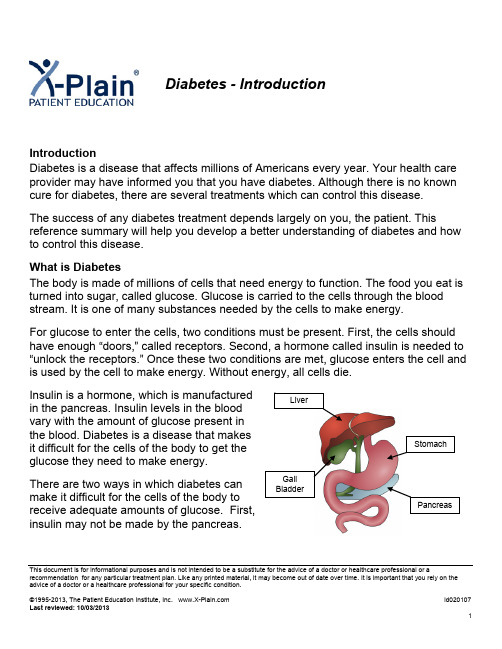
Diabetes - IntroductionIntroductionDiabetes is a disease that affects millions of Americans every year. Your health care provider may have informed you that you have diabetes. Although there is no known cure for diabetes, there are several treatments which can control this disease. The success of any diabetes treatment depends largely on you, the patient. This reference summary will help you develop a better understanding of diabetes and how to control this disease.What is DiabetesThe body is made of millions of cells that need energy to function. The food you eat is turned into sugar, called glucose. Glucose is carried to the cells through the blood stream. It is one of many substances needed by the cells to make energy.For glucose to enter the cells, two conditions must be present. First, the cells should have enough “doors,” called receptors. Second, a hormone called insulin is needed to “unlock the receptors.” Once these two conditions are met, glucose enters the cell and is used by the cell to make energy. Without energy, all cells die.Insulin is a hormone, which is manufacturedin the pancreas. Insulin levels in the bloodvary with the amount of glucose present inthe blood. Diabetes is a disease that makesit difficult for the cells of the body to get theglucose they need to make energy.There are two ways in which diabetes canmake it difficult for the cells of the body toreceive adequate amounts of glucose. First,insulin may not be made by the pancreas.This document is for informational purposes and is not intended to be a substitute for the advice of a doctor or healthcare professional or a recommendation for any particular treatment plan. Like any printed material, it may become out of date over time. It is important that you rely on the advice of a doctor or a healthcare professional for your specific condition.Because insulin is needed to “unlock the receptors,” glucose cannot enter the cells. Therefore, glucose levels increase in the blood. This is known as Type 1 diabetes. Type 2 diabetes occurs when insulin is present in enough quantities, but there is a decrease in the number of receptors on the cells to allow glucose to enter. Even though insulin is present, it cannot be used effectively, a situation called “Insulin Resistance” and results in high levels of glucose in the blood.Type 2 diabetes is more common than Type 1. The exact causes of diabetes are unknown. However, it tends to run in families. Diabetes is not contagious.Signs and Symptoms Of DiabetesDiabetes is detected when your health care provider finds a high level of sugar in your blood or urine. The most reliable test results are obtained when the sugar level in the blood is checked before any food or liquid is ingested. This is known as a fasting blood sugar. A range for a normal fasting blood sugar is between 60 and 99 mg/dL. Levels between 100 and 125 mg/dL are considered pre-diabetic levels.Common signs and symptoms of diabetesinclude:•Excessive thirst.• Frequent urination.• Excessive Hunger.• Weight loss.• Fatigue.• Changes in vision.•Slow-healing cuts or infections.•Persistent itching of the skin.Treatment OptionsDiabetes cannot be cured. It can, however, be controlled by keeping the level of glucose in the blood within its normal range. The treatment and management of diabetes varies from patient to patient. Your health care provider and diabetic care team will decide what form of treatment is best for you.The success of your treatment depends largely on you. When you learn AND practice how to control your glucose level, you will enjoy a healthier life.This document is for informational purposes and is not intended to be a substitute for the advice of a doctor or healthcare professional or a recommendation for any particular treatment plan. Like any printed material, it may become out of date over time. It is important that you rely on the advice of a doctor or a healthcare professional for your specific condition.Controlling DiabetesYou can control diabetes by:This document is for informational purposes and is not intended to be a substitute for the advice of a doctor or healthcare professional or arecommendation for any particular treatment plan. Like any printed material, it may become out of date over time. It is important that you rely on the advice of a doctor or a healthcare professional for your specific condition.1. Eating right.2. Exercising.3. Monitoring your blood glucose level.4. Taking prescribed medications.5. Learning about diabetes.Your dietitian or diabetes educator will explain to you howyou can plan your meals and answer any questions youmay have. The three goals of eating right are:1. Controlling your weight2. Keeping the level of blood glucose at normal levels,and3. Reducing fat in the body.A healthy diet may include changing what you eat, howmuch you eat, and how often you eat. However, you maybe surprised by how many healthy and tasty food options you have.Exercise helps people with diabetes in many ways. It lowers glucose levels, helps weight-loss, and maintains a healthy heart and circulation. In addition, exercisinghelps relieve stress and strengthens muscles. Your health care team will discuss your exercise plan with you. Always check with your health care team before starting a new exercise program.Blood glucose testing is important to find out if your blood glucose level is where itshould be. If your blood glucose is too low or too high, you may need a change in your diabetes medication, diet, or exercise plan. If a change is needed, your health care provider or diabetic care team will give you instructions on what you should do. Your blood glucose level is determined by testing asmall drop of blood obtained from one of your fingers.This drop of blood is obtained by sticking your fingerwith a lancet. Blood glucose is usually checked one tofour times each day, usually before meals. This can bedone at home. Most people with diabetes become verycompetent at checking their own blood glucose.Your diabetes educator will teach you how to test your blood glucose correctly and will tell you the times of day to do the tests. He or she will also teach you how to make changes in diabetes medication, diet, or exercise to help control your blood glucose. The diabetes educator will also review your blood glucose records and make any necessary changes in your therapy.In cases of very high blood glucose levels that do not respond to diet and exercise plans, medications may be needed. You health care provider will tell you if you need medications or insulin. If insulin is needed, it can onlybe injected. Insulin is needed for all patients with Type1 diabetes and for some patients with Type2 diabetes.Blood glucose levels are very important to determinewhether diabetes is controlled at the specific time theblood test is done. There is also another blood testknown as Hemoglobin A1C. This blood test determineshow well glucose has been controlled over the previous3 months. A normal level in people who do not have diabetes is usually 5% or less.People with diabetes should try to maintain their Hemoglobin A1C at 6% or less as long as they don’t have symptoms of hypoglycemia. A 6% level is equivalent to an estimated average blood sugar of 126 mg/dL. The lower the Hemoglobin A1C is, the less the chances of having complications from diabetes.Hyperglycemia (High Blood Sugar)When controlling your diabetes, your blood glucose can become too high or too low. These conditions should be taken seriously. Fortunately, you can regain control of your blood glucose.When too much sugar is in your blood, this condition is called hyperglycemia. Hyper is Greek and means “more.” Glycemia is also Greek and means, "sugar in the blood." Hyperglycemia can be caused by eating too much food, eating sugary, sweet foods, or by not taking your medication. It can also happen when you are sick. If not treated, hyperglycemia can cause you to go into a coma.This document is for informational purposes and is not intended to be a substitute for the advice of a doctor or healthcare professional or a recommendation for any particular treatment plan. Like any printed material, it may become out of date over time. It is important that you rely on the advice of a doctor or a healthcare professional for your specific condition.Signs of high blood sugar, or hyperglycemia, include:This document is for informational purposes and is not intended to be a substitute for the advice of a doctor or healthcare professional or arecommendation for any particular treatment plan. Like any printed material, it may become out of date over time. It is important that you rely on the advice of a doctor or a healthcare professional for your specific condition.• Dry mouth.• Thirst.• Frequent urination.• Blurry vision.• Fatigue or drowsiness.• Weight loss.When you have high blood glucose, drink water or othersugar-free liquids. Check your blood glucose and stick toyour diet plan. If your blood glucose remains high callyour health care team. Your health care team will tell you what is considered high foryou. If it is too high, you may need to go to the hospital.Hypoglycemia (Low Blood Sugar)Hypoglycemia occurs when too little glucose is present in your blood. Hypo is Greek and means “less.” Hypoglycemia usually occurs with patients who take insulin or other medications. It can be caused by taking too much insulin. That is why it is also known as insulin shock. It can also be caused when you decrease your food intake or skip a meal, or when you exercise more than usual.Signs of low blood sugar, or hypoglycemia, include:• Sweating, shaking, nervousness.• Hunger, dizziness, faintness.• Pounding heart, personality change, confused thinking,impatience, crankiness.• Numbness of lips and tongue, headache, blurred vision,and slurred or slowed speech.If not treated, low blood sugar can lead to fainting or seizures. Alow blood sugar can happen quickly and be life threatening.People with diabetes experience different signs when theirblood glucose is low. You should become aware of how youfeel when your blood glucose is too low. Some patients do notexperience any signs when their blood glucose is low.These patients must depend on blood glucose testing to find out if they have hypoglycemia.If you have low blood glucose, immediately eat or drink something containing fast-acting glucose. Examples include any of the following: 3-4 glucose tables, half a cup of fruit juice, 1/2 can of regular soda pop, ten gumdrops, or 2 teaspoons of sugar or honey. If your symptoms do not disappear in 15 minutes or your blood glucose remains less than 80 mg/dL, take another dose of fast-acting sugar. Repeat every 10 to 15 minutes until the blood glucose is greater than 80.If it is less than 30 minutes until your next meal, eat that meal. If it is more than 30 minutes, eat a snack such as half a sandwich or 3 Graham Crackers. Eat the meal or snack after you have taken a dose of fast-acting sugar. Do not subtract the snack from your next meal plan.Do not drive or operate equipment if you feel your blood glucose is low. You should inform your family members and friends that you have diabetes, and if they ever find you unconscious or not making sense, they should take you to a hospital immediately or call “911.”Complications of DiabetesWhen you control the level of glucose in your blood, the signs of diabetes become less frequent. You will feel better and have more energy. If you do not follow your diet, exercise, and perform blood glucose tests, serious complications can arise. Complications of diabetes include damage to the nerves and blood vessels of the body.Nerve damage is known as diabetic neuropathy. It usuallyinvolves the nerves going to the legs and feet. The feet orlegs could feel numb or unusually cold. Non traumaticlower limb amputations can occur in people withuncontrolled diabetes.People with diabetes who have poor sensation in theirfeet must be very careful to avoid damaging their feet withill-fitting shoes, hot water, or other forms of injury. Checkyour feet every day for cuts, sores, redness, or swelling.Use a mirror if needed.This document is for informational purposes and is not intended to be a substitute for the advice of a doctor or healthcare professional or a recommendation for any particular treatment plan. Like any printed material, it may become out of date over time. It is important that you rely on the advice of a doctor or a healthcare professional for your specific condition.When visiting the clinic, ask your health care provider to check your feet.Sexual dysfunction can occur. In men with diabetes, the most common problem is impotence due to damaged nerves going to the sexual organs. Urologists can help treat impotence with surgical and non-surgical treatments. In women with diabetes, damaged nerves in the pelvic organs and genitals can lead to impaired sexual arousal and painful intercourse. If this happens, your health care provider can recommend a treatment.Because the nerves that go to the heart may be affected, people with diabetes who have a heart attack may not experience the typically described chest pain. People with diabetes should therefore be very suspicious when they feel chest heaviness, arm numbness or indigestion. These could be symptoms of a heart attack. Adults with diabetes have heart disease death rates 2 to 4 times higher than adults without diabetes. The risk of stroke is 2 to 4 times higher among people with diabetes.High blood glucose can cause damage to large and small blood vessels. Fat in the blood is deposited on the walls of blood vessels. This causes hardening of the arteries or arteriosclerosis. Hardening of the arteries can occur in arteries leaving or entering the heart. It can also occur in the legs.Your diet plan is designed to lower the level of fat and cholesterol in the blood. When small blood vessels are narrowed by plaque and fat, the blood flow to the organs becomes insufficient. This causes the death of cells dependent on receiving the blood. It can also cause bleeding from narrowed blood vessels.The thickening of small blood vessels is mostnoticeable in the kidney and in the back of the eye.Diabetes is the leading cause of new cases ofblindness among adults.Diabetes may stop the kidneys from cleaning wasteout of the blood. In addition, proteins that shouldstay in the body may leak into the urine. Yourhealth care provider can test for small amounts ofprotein in your urine to determine if there are earlysigns of kidney diseases. Diabetes is the leading cause of kidney failure.This document is for informational purposes and is not intended to be a substitute for the advice of a doctor or healthcare professional or a recommendation for any particular treatment plan. Like any printed material, it may become out of date over time. It is important that you rely on the advice of a doctor or a healthcare professional for your specific condition.People with diabetic kidney disease often develop high blood pressure. It is very important that the high blood pressure be treated with blood pressure lowering medicines because this helps to prevent worsening of the kidney problems.If you have diabetic kidney disease, your health care provider may also prescribe a special diet that is low in protein and restricted in salt. In rare cases, dialysis and even kidney transplants may become necessary.Gum disease is more common in people with diabetes. Among young adults, those with diabetes have about twice the risk of gum disease as those without diabetes. If you have diabetes and smoke, talk to you health care provider about smoking cessation support.All health care providers feel that controlling your diabetes will help prevent damage to blood vessels and nerves. Proper control of diabetes is a combination of diet plan, medication, exercise, blood glucose monitoring, and good hygiene.SummaryThanks to advances in medicine, diabetes can be successfully controlled. The role of the patient is essential in making a diabetes management plan succeed.Diabetes management consists of:This document is for informational purposes and is not intended to be a substitute for the advice of a doctor or healthcare professional or arecommendation for any particular treatment plan. Like any printed material, it may become out of date over time. It is important that you rely on the advice of a doctor or a healthcare professional for your specific condition.• Following a diet plan• Testing blood sugar• Exercising• Taking all prescribed medication on time• Ensuring good hygiene• Learning about diabetesYour diabetic health care team will explain to you yourspecific diabetes control plan. When you follow these instructions, the possibility of experiencing the problems of diabetes discussed in this program can be significantlyreduced.This reference summary is made available to you by your health care team to help you enjoy a healthier lifestyle while controlling diabetes.。
糖尿病名词解释
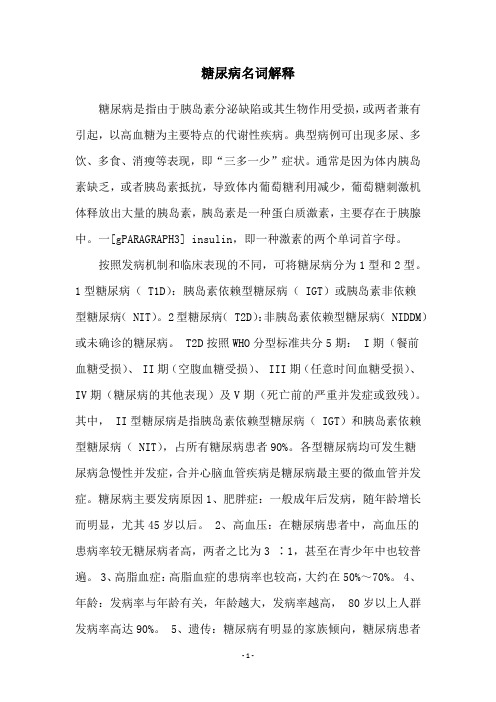
糖尿病名词解释糖尿病是指由于胰岛素分泌缺陷或其生物作用受损,或两者兼有引起,以高血糖为主要特点的代谢性疾病。
典型病例可出现多尿、多饮、多食、消瘦等表现,即“三多一少”症状。
通常是因为体内胰岛素缺乏,或者胰岛素抵抗,导致体内葡萄糖利用减少,葡萄糖刺激机体释放出大量的胰岛素,胰岛素是一种蛋白质激素,主要存在于胰腺中。
一[gPARAGRAPH3] insulin,即一种激素的两个单词首字母。
按照发病机制和临床表现的不同,可将糖尿病分为1型和2型。
1型糖尿病( T1D):胰岛素依赖型糖尿病( IGT)或胰岛素非依赖型糖尿病( NIT)。
2型糖尿病( T2D):非胰岛素依赖型糖尿病( NIDDM)或未确诊的糖尿病。
T2D按照WHO分型标准共分5期: I期(餐前血糖受损)、 II期(空腹血糖受损)、 III期(任意时间血糖受损)、IV期(糖尿病的其他表现)及V期(死亡前的严重并发症或致残)。
其中, II型糖尿病是指胰岛素依赖型糖尿病( IGT)和胰岛素依赖型糖尿病( NIT),占所有糖尿病患者90%。
各型糖尿病均可发生糖尿病急慢性并发症,合并心脑血管疾病是糖尿病最主要的微血管并发症。
糖尿病主要发病原因1、肥胖症:一般成年后发病,随年龄增长而明显,尤其45岁以后。
2、高血压:在糖尿病患者中,高血压的患病率较无糖尿病者高,两者之比为3 ∶1,甚至在青少年中也较普遍。
3、高脂血症:高脂血症的患病率也较高,大约在50%~70%。
4、年龄:发病率与年龄有关,年龄越大,发病率越高, 80岁以上人群发病率高达90%。
5、遗传:糖尿病有明显的家族倾向,糖尿病患者亲属的患病率比非糖尿病者亲属高2~3倍。
6、妊娠:糖尿病的母亲,其子女发病率比正常妇女的子女高出20倍。
7、其他因素:进食过多,活动减少,体力活动减少,静坐生活方式增加,精神心理紧张,应激状态等也易致糖尿病。
糖尿病病人如何饮食?糖尿病的治疗原则包括:预防和控制高血糖,纠正高血糖和高血脂。
糖尿病查房相关英文词汇
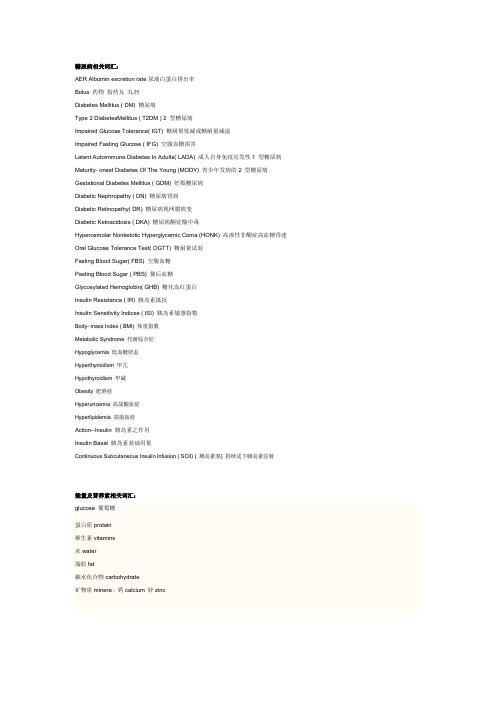
糖尿病相关词汇:AER Albumin excretion rate尿液白蛋白排出率Bolus 药物指药丸丸剂Diabetes Mellitus ( DM) 糖尿病Ty pe 2 DiabetesMellitus ( T2DM ) 2 型糖尿病Impaired Glucose Tolerance( IGT) 糖耐量低减或糖耐量减退Impaired Fasting Glucose ( IFG) 空腹血糖损害Latent Autoimmune Diabetes In Adults( LADA) 成人自身免疫迟发性1 型糖尿病Maturity- onset Diabetes Of The Young (MODY) 青少年发病的2 型糖尿病Gestational Diabetes Mellitus ( GDM) 妊娠糖尿病Diabetic Nephropathy ( DN) 糖尿病肾病Diabetic Retinopathy( DR) 糖尿病视网膜病变Diabetic Ketoacidosis ( DKA) 糖尿病酮症酸中毒Hy perosmolar Nonketotic Hy pergly cemic Coma (HONK) 高渗性非酮症高血糖昏迷Oral Glucose Tolerance Test( OGTT) 糖耐量试验Fasting Blood Sugar( FBS) 空腹血糖Pasting Blood Sugar ( PBS) 餐后血糖Gly cosylated Hemoglobin( GHB) 糖化血红蛋白Insulin Resistance ( IR) 胰岛素抵抗Insulin Sensitiv ity Indices ( ISI) 胰岛素敏感指数Body- mass Index ( BMI) 体重指数Metabolic Syndrome 代谢综合征Hypoglycemia 低血糖状态Hyperthy roidism 甲亢Hypothy roidism 甲减Obesity 肥胖症Hyperuricemia 高尿酸血症Hyperlipidemia 高脂血症Action--Insulin 胰岛素之作用Insulin Basal 胰岛素基础用量Continuous Subcutaneous Insulin Infusion ( SCII) ( 胰岛素泵) 持续皮下胰岛素注射能量及营养素相关词汇:glucose 葡萄糖蛋白质protein维生素v itamins水water脂肪f at碳水化合物carbohy drate矿物质minera : 钙calcium 锌zinc饮食相关词汇:snack start 零食或辅助饮食Meal Markers 膳食标准一.肉类:1.鸡鸭:Fresh Grade Legs(thigh) 鸡大腿Fresh Grade Breast 鸡胸chicken f ry er 小鸡块Chicken Drumsticks 鸡小腿Chicken Wings 鸡翅Turkey 火鸡chick gizzard鸡杂Duck trim drum鸭翼脾2.猪肉:Liv er 猪Pork ribs 排骨f eet 猪脚Kidney猪腰bag 猪肚Hearts 猪心Pork Steak 猪排Pork-pieces 廋肉块Pork Chops 连骨猪排Rolled Pork loin 卷好的腰部瘦肉Rolled Pork Belly卷好的腰部瘦肉连带皮Pork sausage meat 做香肠的绞肉Pork Fillet 小里肌肉Spare Rib Pork chops 带骨的瘦肉Spare Rib of Pork 小排骨肉Pork Dripping 猪油滴Lard 猪油Joint 有骨的大块肉Hock 蹄膀Casserole Pork 中间带骨的腿肉Butt猪的肩前腿肉3.牛肉: Stewing Beef小块的瘦肉Steak & Kidney牛肉块加牛腰ground beef已铰好的牛肉Fry ing steak 可煎食的大片牛排Rump Steak 大块牛排Leg Beef牛键肉OX-Tail 牛尾OX-heart 牛心Homey come Tripe 蜂窝牛肚OX-Tongues 牛舌Barnsley Chops 带骨的腿肉Shoulder Chops 肩肉Porter House Steak 腰上的牛排肉Chuck Steak 头肩肉筋、油较多Tenderised Steak 拍打过的牛排Roll 牛肠Cowhells 牛筋Tripe Pieces 牛肚块Best thick seam 白牛肚4.羊肉:lamb chops羊肉片leg of lamb 羊腿二. .海产类(Seaf ood)1.鱼(f ish):Herring 青鱼,鲱Salmon三文鱼Bass 鲈鱼Corv ina黄花鱼Milkf ish奶鱼Mullet梭鱼,胭脂鱼, 鲻鱼Cod 鳕鱼Tuna金枪鱼Sea Bream 海鲤Hake 鳕鱼类Carp 鲤鱼Halibut 大比目鱼f lounder比目鱼Plaice欧蝶鱼Swordf ish箭鱼Octopus 鱆鱼Squid 乌贼cuttlef ish 墨鱼Dressed squid 花枝Mackerel 鲭Haddock 北大西洋鳕鱼Trout鲑鱼Cod Fillets 鳕鱼块Conger (Eel)鳗鱼Tilapia罗非鱼Dace鲮鱼Red Mullet 红鲣Herring roes 鲱鱼子Boiled Cod roes 鳕鱼子 2.贝类海鲜(Shellf ish): Oysters 牡_? Mussels 蚌类、黑色、椭圆形、没壳的是淡菜Crab 螃蟹Prawn 虾clams 蛤蚌scallops扇贝(小) Crab stick 蟹肉条Peeled Prawns 虾仁King Prawns 大虾Tiger Prawns 虎虾Whelks Tops 小螺肉Shrimps 基围虾Cockles 小贝肉Lobster 龙Winkles 田螺三.蔬菜类(Vegetables):Daikon白萝卜Carrot 胡萝卜Radish 小胡萝卜Tomato 蕃茄Parsnip 欧洲萝卜Bok-choy小白菜long napa(suey choy) 大白菜Spinach菠菜Cabbage 卷心菜Potato 马铃薯russet potato褐色土豆Sweet potato红薯(红苕)Eggplant茄子Celery芹菜Celery stalk芹菜梗Asparagus芦笋Lotus root莲藕Cilantro芫荽叶Caulif lower 白花菜Broccoli 绿花菜Spring onions(scallion 或green onion)葱Zucchini美洲南瓜(西葫芦)Mushroom 洋菇Chiv es Flower韭菜花shallot葱Red cabbage 紫色包心菜Squash(pumpkin)南瓜acorn squash小青南瓜Watercress 西洋菜豆瓣菜Baby corn 玉米尖Sweet corn 玉米Bitter melon苦瓜Beet甜菜chard甜菜Onion 洋葱lima bean 青豆Brussels sprout 球芽甘蓝(小包菜)Garlic 大蒜Ginger(root)姜Leeks韭菜Scallion(green onion) 葱Mustard & cress 芥菜苗Artichoke洋蓟Escarole 菊苣, 茅菜Chilly辣椒Green Pepper 青椒Red pepper 红椒Yellow pepper 黄椒Courgette小胡瓜,绿皮番瓜(不可生食)Coriander 香菜Cucumber黄瓜String bean(green bean)四季豆Pea豌豆lima bean青豆Bean sprout 绿豆芽Iceberg 透明包菜Lettuce 生菜romaine莴苣Swede or Turnip 芜菁Okra 秋葵Taro 大芋头Eddo 小芋头y am山药, 洋芋kale羽衣甘蓝四.水果类(f ruits):apple苹果peach桃子Lemon 柠檬Pear 梨子av ocado南美梨cantaloupe美国香瓜Banana 香蕉Grape 葡萄raisins葡萄干plum 李子apricot杏子nectarine油桃honey dew(melon)哈密瓜orange 橙子tangerine 橘子guav a番石榴Golden apple 黄绿苹果、脆甜Granny smith 绿苹果papay a木瓜Bramley绿苹果Mclntosh麦金托什红苹果coconut椰子nut核果,坚果Strawberry草莓prunes干梅子blueberry乌饭果cranberry酸莓raspberry山霉Mango 芒果f ig 无花果pineapple 菠萝Kiwi 奇异果(弥猴桃)Star f ruit 杨桃Cherry 樱桃watermelon西瓜grapef ruit柚子lime 酸橙Dates 枣子ly chee 荔枝Grape f ruit 葡萄柚Coconut 椰子f ig 无花果五.熟食类(deli):sausages 香肠corned beef腌咸牛肉bologna大红肠salami 意大利香肠bacon熏肉ham火腿肉stewing beef炖牛肉Smoked Bacon 熏肉roast烤肉corned beef咸牛肉Pork Burgers 汉堡肉potato salad凉拌马铃薯core slaw凉拌卷心菜丝macaroni salad 凉拌空心面seaf ood salad凉拌海鲜Smoked mackerel with crushed pepper corn 带有黑胡椒粒的熏鲭Dried f ish 鱼干Canned罐装的Black Pudding 黑香肠smoked Salmon 熏三文鱼六.谷类食品(Cereals):1.米类:Long rice 长米,较硬Pudding rice or short rice 软短米Brown rice 糙米THAI Fragrant rice 泰国香米Glutinous rice 糯米Sago 西贾米oat燕麦, 麦片粥2.面类:Strong f lour 高筋面粉Plain f lour 中筋面粉macaroni 意大利空心面spaghetti意大利式细面条Self- raising f lour 低筋面粉Whole meal f lour 小麦面粉Instant noodle方便面Noodles 面条Rice-noodle 米粉Vermicelli(rice stick)细面条, 粉条七.调味品类(Seasoning,condiments,relish):Brown sugar 砂糖dark Brown Sugar 红糖Rock Sugar 冰糖Maltose 麦芽糖Custer sugar 白砂糖(适用于做糕点)Icing Sugar 糖粉(可用在打鲜奶油及装饰蛋糕外层)Soy sauce 酱油,分生抽(light)及老抽两种Vinegar 醋Cornstarch 太白粉,玉米淀粉Sesame Seeds 芝麻Sesame oil 麻油cooking oil 菜油oliv e oil橄榄油(植物油)Creamed Coconut 椰油Oy ster sauce 蚝油Canola oil 加拿大芥花油(菜油)broth 肉汤Pepper 胡椒Chinese red pepper 花椒monosodium glutamate味精Red chilli powder 辣椒粉sesame芝麻Sesame paste 芝麻酱Salt black bean 豆鼓peanut butter花生酱Bean curd sheet 腐皮Tof u 豆腐bean curd豆干,干子Sea v egetable or Sea weed 海带Green bean 绿豆Red Bean 红豆Black bean 黑豆Red kidney bean 大红豆Dried mushroom 冬菇Silk noodles 粉丝hazelnut榛子almond杏仁Agar-agar 燕菜Bamboo shoots 竹笋罐头Star anise 八角f ennel茴香clov e丁香Wantun skin 馄饨皮Dried chestnut 干粟子Tiger lily buds 金针Red date 红枣Water chestnuts 荸荠罐头Dried shrimps 虾米Cashew nuts 腰果walnut胡桃cream 奶油cheddar cheese 英国切达干酪butter 黄油margarine 植物奶油cream cheese干酪cottage cheese 白干酪mozzarella 意大利白干酪y ogurt 酸奶juice 果汁marmalade橘子或柠檬酱jelly果冻Cake mix蛋糕粉sy rup糖浆, 果汁salad dressing沙拉酱mashed potatoes土豆泥sundae圣代冰淇淋jam果酱marmalade橘子酱mustard 芥末ketchup调味番茄酱spices 香料Skim milk脱脂牛奶Low-f at milk低脂牛奶Buttermilk 脱脂酸牛奶soy a drink 豆浆八.零食糖果类(Snack Foods and Conf ectionery):Biscuits 点心crackers 咸饼干bulk bagels 散装硬面包圈Cookies 小甜饼干muff ins 松饼Pretzels 焦盐脆饼条popcorn爆玉米花nuts果仁peanut花生potato chips 炸马铃薯片corn chips炸玉米片tortilla chips 墨西哥炸玉米片nacho chips墨西哥辣炸玉米片crisps 各式洋芋片tortilla玉米粉圆饼Bun小圆面包,圈taco墨西哥玉米面豆卷pancake薄烤饼French f ries炸薯条ice cream cone 圆筒冰淇淋九.腌菜(Pickles)Sour mustard 咸酸菜preserv ed mustard 泡菜preserv ed pickle榨菜Pickled mustard-green 酸菜。
医学英语课后翻译习题答案5-8
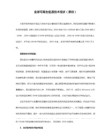
The capacity of marrow to respond(to the anemia) depends on the level of erythropoietin stimulaiton.
15. 慢性内出血诊断更难。
Slower bleeding internally can be harder to diagnose.
7. 减少食物中胆固醇量
reducing intake of protein and phosphate
8. 肾脏具有强大的功能储备
The kidneys have a large functional reserve.
9. 在等待肾移植时,可以进行血液透析
Dialysis is used while waiting for a suitable transplant opportunity.
12. 肾脏衰竭通常是一个渐进性的过程
Usually kidney failure is a gradual process.
13. 如果肾单位不能进行滤过,肾脏将停止工作
If nephrons don't carry out the filtering process, the kidney will stop functioning.
Unit 7
1. 中风 stroke, apoplexy
2. 瘫痪paralysis
3. 康复rehabilitation
4. 中枢神经系统central nervous system
5. 周围神经系统 peripheral nervous system
医学常用医学专业词汇英语翻译

医学常用医学专业词汇英语翻译Medical Terminology Translation in EnglishIntroduction:Medical terminology plays a crucial role in the healthcare field, serving as a common language among healthcare professionals worldwide. As the globalization of medicine continues to increase, the accurate translation of medical terms from one language to another becomes essential. This article aims to provide translations of commonly used medical terms from Chinese to English to facilitate effective communication in the medical field.1. Anatomical Terms:1.1 Head (头部): Cranium1.2 Chest (胸部): Thorax1.3 Stomach (胃): Gastric1.4 Intestine (肠): Intestinal1.5 Heart (心脏): Cardiac2. Medical Conditions:2.1 Hypertension (高血压): High blood pressure2.2 Diabetes (糖尿病): Diabetes mellitus2.3 Asthma (哮喘): Asthma2.4 Depression (抑郁症): Depression2.5 Arthritis (关节炎): Arthritis3. Diagnostic Procedures:3.1 X-ray (X光): X-ray3.2 Ultrasound (超声波): Ultrasound3.3 MRI (磁共振成像): Magnetic Resonance Imaging3.4 CT scan (计算机断层扫描): Computed Tomography scan3.5 Endoscopy (内窥镜检查): Endoscopy4. Medications:4.1 Antibiotic (抗生素): Antibiotic4.2 Analgesic (止痛药): Painkiller4.3 Antihistamine (抗组胺药): Antihistamine4.4 Antidepressant (抗抑郁药): Antidepressant4.5 Anticoagulant (抗凝血药): Anticoagulant5. Surgical Procedures:5.1 Appendectomy (阑尾切除术): Appendectomy5.2 Cholecystectomy (胆囊切除术): Cholecystectomy5.3 Mastectomy (乳腺切除术): Mastectomy5.4 Rhinoplasty (隆鼻术): Rhinoplasty5.5 Colonoscopy (结肠镜检查): Colonoscopy6. Medical Professionals:6.1 Physician (医生): Doctor / Physician6.2 Nurse (护士): Nurse6.3 Surgeon (外科医生): Surgeon6.4 Pharmacist (药剂师): Pharmacist6.5 Radiologist (放射科医生): Radiologist7. Body Systems:7.1 Respiratory System (呼吸系统): Respiratory System7.2 Digestive System (消化系统): Digestive System7.3 Cardiovascular System (心血管系统): Cardiovascular System7.4 Nervous System (神经系统): Nervous System7.5 Musculoskeletal System (骨骼肌肉系统): Musculoskeletal SystemConclusion:Accurate translation of medical terms is vital for efficient communication in the healthcare field. The provided translations of commonly used medical terms aim to facilitate effective cross-linguistic understanding among medical professionals. As the field of medicinecontinues to develop and evolve, it is essential to stay updated with the latest terminology and ensure accurate communication in both spoken and written English.。
糖尿病 英文作文带翻译
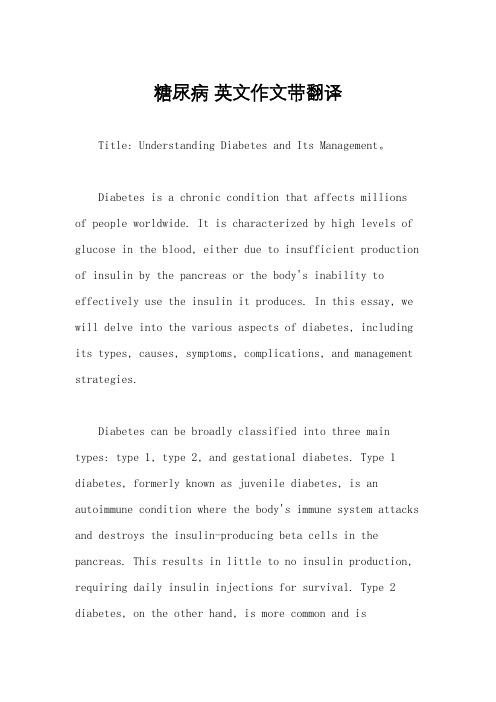
糖尿病英文作文带翻译Title: Understanding Diabetes and Its Management。
Diabetes is a chronic condition that affects millions of people worldwide. It is characterized by high levels of glucose in the blood, either due to insufficient production of insulin by the pancreas or the body's inability to effectively use the insulin it produces. In this essay, we will delve into the various aspects of diabetes, including its types, causes, symptoms, complications, and management strategies.Diabetes can be broadly classified into three main types: type 1, type 2, and gestational diabetes. Type 1 diabetes, formerly known as juvenile diabetes, is an autoimmune condition where the body's immune system attacks and destroys the insulin-producing beta cells in the pancreas. This results in little to no insulin production, requiring daily insulin injections for survival. Type 2 diabetes, on the other hand, is more common and ischaracterized by insulin resistance, where the body's cells do not respond effectively to insulin. This leads to high blood sugar levels, and while the pancreas may produce insulin, it's often not enough to meet the body's needs. Gestational diabetes occurs during pregnancy and usually resolves after childbirth, but it increases the risk ofboth the mother and child developing type 2 diabetes laterin life.The exact causes of diabetes vary depending on the type. Type 1 diabetes is believed to have a genetic predisposition, although environmental factors such asviral infections may trigger its onset. Type 2 diabetes is closely linked to lifestyle factors such as poor diet, lack of physical activity, obesity, and genetics. Gestational diabetes is thought to result from hormonal changes during pregnancy that affect insulin sensitivity.Regardless of the type, diabetes shares common symptoms such as increased thirst, frequent urination, unexplained weight loss, fatigue, and blurred vision. If left untreated, diabetes can lead to serious complications such as heartdisease, stroke, kidney failure, nerve damage, and blindness. Therefore, early detection and proper management are crucial in preventing these complications.Management of diabetes revolves around maintainingblood sugar levels within a target range to prevent hyperglycemia (high blood sugar) and hypoglycemia (lowblood sugar). This often involves a combination of medication, dietary changes, regular exercise, monitoring blood sugar levels, and, in the case of type 1 diabetes, insulin therapy. Medications commonly used to treat type 2 diabetes include oral hypoglycemic agents such as metformin, sulfonylureas, and insulin sensitizers like thiazolidinediones.Diet plays a fundamental role in diabetes management. A balanced diet rich in whole grains, fruits, vegetables,lean proteins, and healthy fats can help regulate blood sugar levels and prevent complications. Carbohydrate counting is often recommended for individuals using insulin to match their insulin dose with their carbohydrate intake.Regular physical activity is also essential for managing diabetes as it improves insulin sensitivity and helps control weight. Aerobic exercises such as walking, cycling, swimming, and strength training are beneficial for lowering blood sugar levels and reducing the risk of cardiovascular disease.In addition to medication, diet, and exercise, monitoring blood sugar levels is vital for adjusting treatment plans and preventing complications. Self-monitoring of blood glucose levels using a glucometer allows individuals to track their blood sugar levels throughout the day and make necessary adjustments to their medication, diet, or physical activity.In conclusion, diabetes is a complex condition that requires lifelong management to prevent complications and maintain overall health. By understanding the different types, causes, symptoms, and management strategies of diabetes, individuals can take control of their health and lead fulfilling lives despite their diagnosis.糖尿病是一种慢性疾病,影响着全球数百万人。
糖尿病
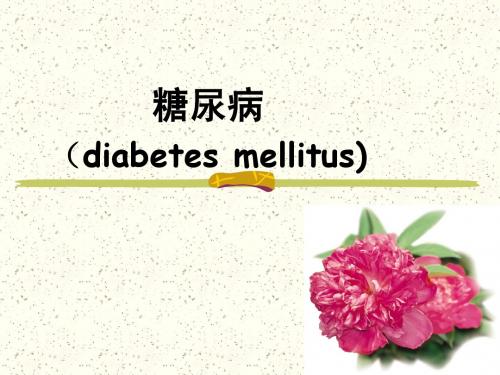
(二)病毒感染
重要的环境因素之一;1864年,挪威医生报道1 例在腮腺炎病毒感染后发生糖尿病;腮腺炎病 毒、风疹病毒、巨细胞病毒、柯萨奇B病毒等与 1型糖尿病的发生有关
(三)自身免疫
1型糖尿病患者体内存在多种胰岛素自身抗体, 如:胰岛细胞表面抗体、抗胰岛素自身抗体 1型糖尿病及其亲属常伴有其他自身免疫性疾病, 如甲状腺功能亢进症、桥本甲状腺炎、原发性 肾上腺皮质功能减退症、恶性贫血、重症肌无 力、类风湿关节炎等
假阳性:妊娠时肾糖阈下降,血糖正常,尿糖可 阳性 假阴性:并发肾小球动脉硬化时,GFR下降,肾 糖阈升高,尿糖可呈假阴性
2.血糖测定
空腹及餐后2小时血糖增高是诊断糖尿病 的主要依据 空腹静脉血正常范围3.9~5.6mmol/L ( 3.9~6.4mmol/L )
WHO专家委员会报告,1999年糖尿病诊断
血 糖尿病 空腹和(或) 服糖后2h 葡萄糖耐量异常 空腹 服糖后2h 糖 值(单位: mmol/L) Cap全血 ≥ 6.1 ≥11.1
<6.1 ≥7.8~<11.0
静脉全血 ≥6.1 ≥10.0
<6.1 ≥6.7~<9.9
静脉血浆 ≥ 7.0 ≥11.1
<7.0 ≥7.8~<11.0
3.口服葡萄糖耐量试验(OGTT)
(四)诱发因素(2型糖尿病)
肥胖:约有60%-80%的成年糖尿病患者在发 病前均为肥胖者,肥胖的程度与糖尿病的发病 率呈正比,尤其是中心型肥胖 体力活动减少 饮食改变 感染:呼吸道等感染 创伤和手术 精神刺激:伴随着精神的紧张、情绪的激动及 各种应激状态,会引起升高血糖激素的大量分 泌,如生长激素、去甲肾上腺素、胰升糖素及 肾上腺皮质激素等 多次妊娠和分娩等
糖尿病足:糖尿病病人因末梢神经病变,下肢动脉供血不足以及细 菌感染等各种因素,引起足部疼痛、皮肤深溃疡、肢端坏疽等病变, 统称为糖尿病足。
- 1、下载文档前请自行甄别文档内容的完整性,平台不提供额外的编辑、内容补充、找答案等附加服务。
- 2、"仅部分预览"的文档,不可在线预览部分如存在完整性等问题,可反馈申请退款(可完整预览的文档不适用该条件!)。
- 3、如文档侵犯您的权益,请联系客服反馈,我们会尽快为您处理(人工客服工作时间:9:00-18:30)。
DiabetesDiabetes(糖尿病) is a condition where the body is unable to automatically regulate blood glucose levels, resulting in too much glucose in the blood.糖尿病是一个条件,身体无法自动调节血糖水平,导致血液中过多的葡萄糖。
Glucose(葡萄糖) comes from foods that contain carbohydrate(碳水化合物),for example, breads and cereals(谷物,谷类) , milk and dairy foods, fruits and some vegetables. Glucose travels in the bIood stream to the muscles and other organs where it is used as fuel. Excess glucose is detoured(绕道) to the liver where it is stored for future use. Glucose is the body's preferred(首选的) source of energy and our bodies need it to work efficiently , just like a car need petrol to run.葡萄糖来自于含有碳水化合物的食物,例如,面包和谷类食品,牛奶和乳制品的食品,水果和一些蔬菜。
葡萄糖在救护车流到肌肉和其他器官,用作燃料。
多余的葡萄糖是遭遇肝脏存储以供将来使用。
葡萄糖是身体的首选源的能量,我们的身体需要有效地工作,就像汽车需要汽油。
The blood glucose level is regulated with the help of insulin, a hormone(or chemical messenger) made in the pancreas(胰腺) . Insulin is the key that glucose needs to enter the body's cells so that it can be used as fuel. Diabetes develops when the pancreas stops producing insulin or when the body does not respond properly to insulin. There are two major types of diabetes: Type 1 , a disease in which the body does not produce any insulin, most often occurs in children and young adults. People with Type1 diabetes must take daily insulin injection to stay alive. Type 1 diabetes accounts for 5 to 10 percent of diabetes. Type2,a metabolic disorder resulting from the body's inability to make enough or properly use of insulin. It is the most common form of the disease. Type2 diabetes accounts for 90 to 95 percent of diabetes. Type2 diabetes is nearing epidemic(流行的) proportions, due to an increased number of older people, and a greater prevalence of obesity and sedentary lifestyles. Insulin injections are necessary to treat Typel diabetes. Type2 diabetes can usually be controlled in the first instance by regular exercise and diet. Tablets(药片) and eventually(最终) insulin injections may be needed as the disease prognsses.血糖水平的调节胰岛素的帮助下,一种激素(或化学信使)胰腺。
胰岛素是关键,葡萄糖需要进入人体细胞,以便它可以作为燃料。
糖尿病发展当胰腺停止生产胰岛素或当身体不正确地响应胰岛素。
糖尿病的主要有两种类型:1型,一种疾病的身体不会产生任何胰岛素,最常发生在儿童和年轻人。
1型糖尿病患者必须每天注射胰岛素。
1型糖尿病占5 - 10%的糖尿病。
类型2,造成代谢紊乱身体无法赚到足够的或正确使用胰岛素。
这是最常见的疾病。
类型2型糖尿病占90 - 95%的糖尿病。
类型2糖尿病是接近流行,由于老年人数量的增加,和一个更大的普遍肥胖和久坐不动的生活方式。
胰岛素注射治疗Typel糖尿病是必要的。
类型2糖尿病通常可以首先通过有规律的锻炼和控制饮食。
平板电脑和最终疾病prognsses可能需要注射胰岛素。
The normal blood glucose level ranges between 3.5-7.8 mmol/L. Over time, high blood glucose levels may damage blood vessels and nerves. These complications of diabetes can cause damage to eyes, nerves and kidneys and increase the risk of heart attack(心脏病发作) , stroke, impotence(阳痿) and foot problems. This damage can happen before an individual knowsif the has diabetes or if diabetes is undetected for a long time. Studies have shown that if blood glucose and cholesterol(胆固醇) levels, and blood pressure are kept within normal limits, the risk of damage to the body isreduced. Therefore, it is important to know if you have diabetes. The symptoms of diabetes include: thirst, frequent urination(排尿) , tiredness or lack of energy, blurred(模糊不清的) vision, infection (e.g. thrush), weight loss. However, the symptoms of diabetes may not appear until blood glucose levels are above approximately 15mmol/L or higher. So, it is common to have diabetes without knowing about it. In Australia, one adult in twelve has diabetes and the prevalence is increasing, Research has shown that for every person with known diabetes, there is another who has it but has not yet been diagnosed.正常血糖范围3.5-7.8 mmol/L之间随着时间的推移,高血糖会损害血管和神经。
这些糖尿病并发症会造成对眼睛的伤害,神经和肾脏,增加心脏病发作,中风的危险,阳痿和足部问题。
这种损伤可以在一个人知道如果有糖尿病或者糖尿病被发现很长一段时间。
有研究表明,如果血糖和胆固醇水平,血压保持在正常范围内,减少对身体的损害风险。
因此,它是要知道如果你有糖尿病,重要的。
糖尿病的症状包括:口渴,尿频,疲劳或乏力,视力模糊,感染(如鹅口疮),减肥。
然而,糖尿病症状可能直到血糖水平高于约15mmol/L以上出现。
因此,它是常见的有糖尿病,不知道它。
在澳大利亚,十二个成年人糖尿病的患病率不断增加,研究表明一个人与已知的糖尿病,还有一个谁拥有它但尚未确诊。
The development of diabetes is influenced by our lifestyle and our genes. We can identify some factors that predispose(使偏向于) people to developing Type2 diabetes. Having one or more of the following risk factors, increases the risk of developing diabetes or of having undiagnosed Type2 diabetes. One factor is age. As we get older,we become less active, and may gain excess weight. This weight tends to he stored around the abdomen(腹部) and upper body. Less activity and weight gain resuft in the body's insulin becoming less effective. a term called insmin resistance. over the age of 65. the incidence of Type2 diabetes affects 1 in 5 people. Anothor risking factor is the weight and body mass index ( BMI ). which is also anindication of whether your weight is in the healthy weight range in relation to yourheight. In Caucasian people. a BMI of 20-25 indicates a healthy weight range. Over 25 indicatcs the overweight range. Some people, e.g. Asian, AsianIndian and Indigenous Australians,arc healthy at a lower BMI range. 19-23 is the ideal range for people from these backrounds. However. weight is only part of the equation. Of greater significance is body composition, i.e. the amount of muscle compared to fat in the body. and where fat is stored in the body. Fat that is stored around the upper body or abdomen is less healthy than fat that is stored on the hips(臀部) and thighs. Abdominal fat is associated with an increased risk of high blood prcssure, high blood fats(cholesterol and triglycerides甘油三酯) and diabetes.糖尿病的发展是由我们的生活方式和基因的影响。
